Food and Safety Management in Hospitality Industry
VerifiedAdded on 2023/06/11
|22
|5809
|267
AI Summary
This article discusses the importance of food safety and hygiene in the hospitality industry. It covers the control measures for preventing physical and chemical contamination, characteristics of food poisoning and food-borne infections, and food spoiler agents. The article also provides information on food preservation, temperature control, and safe storage of food. The subject covered is Food and Safety Management, and the course code is not mentioned. The article is relevant to students studying hospitality management in any college or university.
Contribute Materials
Your contribution can guide someone’s learning journey. Share your
documents today.
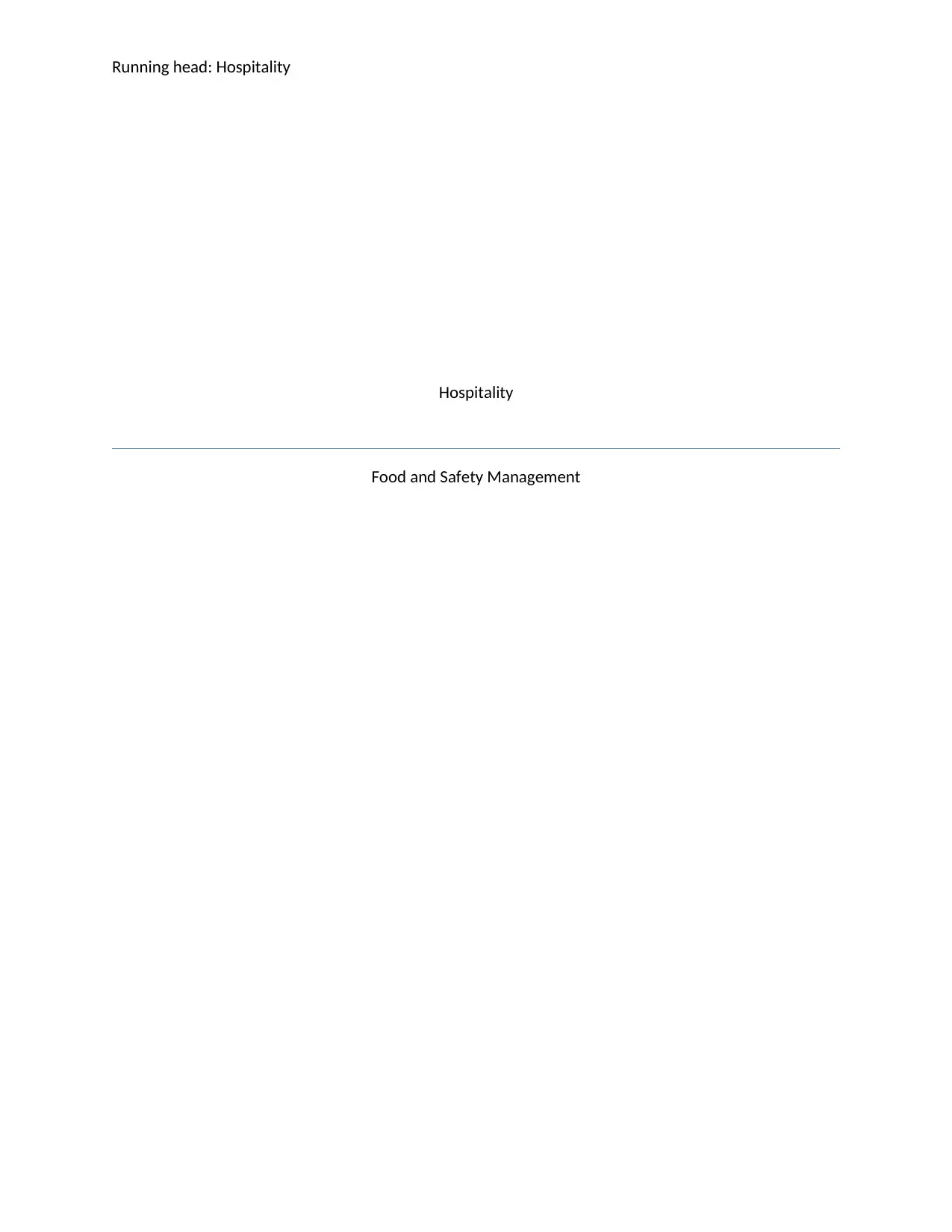
Running head: Hospitality
Hospitality
Food and Safety Management
Hospitality
Food and Safety Management
Secure Best Marks with AI Grader
Need help grading? Try our AI Grader for instant feedback on your assignments.
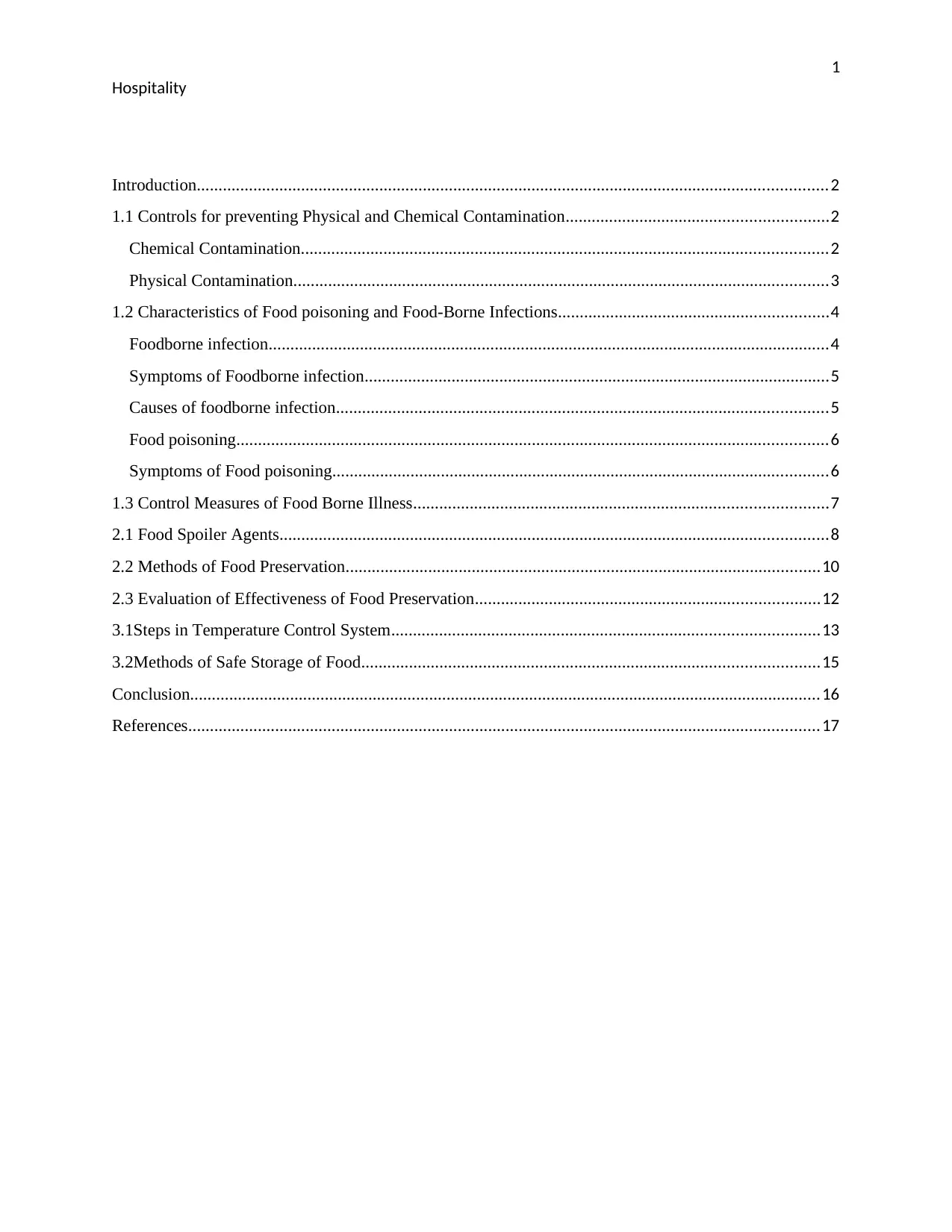
1
Hospitality
Introduction.................................................................................................................................................2
1.1 Controls for preventing Physical and Chemical Contamination............................................................2
Chemical Contamination.........................................................................................................................2
Physical Contamination...........................................................................................................................3
1.2 Characteristics of Food poisoning and Food-Borne Infections..............................................................4
Foodborne infection.................................................................................................................................4
Symptoms of Foodborne infection...........................................................................................................5
Causes of foodborne infection.................................................................................................................5
Food poisoning........................................................................................................................................6
Symptoms of Food poisoning..................................................................................................................6
1.3 Control Measures of Food Borne Illness...............................................................................................7
2.1 Food Spoiler Agents..............................................................................................................................8
2.2 Methods of Food Preservation.............................................................................................................10
2.3 Evaluation of Effectiveness of Food Preservation...............................................................................12
3.1Steps in Temperature Control System..................................................................................................13
3.2Methods of Safe Storage of Food.........................................................................................................15
Conclusion.................................................................................................................................................16
References.................................................................................................................................................17
Hospitality
Introduction.................................................................................................................................................2
1.1 Controls for preventing Physical and Chemical Contamination............................................................2
Chemical Contamination.........................................................................................................................2
Physical Contamination...........................................................................................................................3
1.2 Characteristics of Food poisoning and Food-Borne Infections..............................................................4
Foodborne infection.................................................................................................................................4
Symptoms of Foodborne infection...........................................................................................................5
Causes of foodborne infection.................................................................................................................5
Food poisoning........................................................................................................................................6
Symptoms of Food poisoning..................................................................................................................6
1.3 Control Measures of Food Borne Illness...............................................................................................7
2.1 Food Spoiler Agents..............................................................................................................................8
2.2 Methods of Food Preservation.............................................................................................................10
2.3 Evaluation of Effectiveness of Food Preservation...............................................................................12
3.1Steps in Temperature Control System..................................................................................................13
3.2Methods of Safe Storage of Food.........................................................................................................15
Conclusion.................................................................................................................................................16
References.................................................................................................................................................17
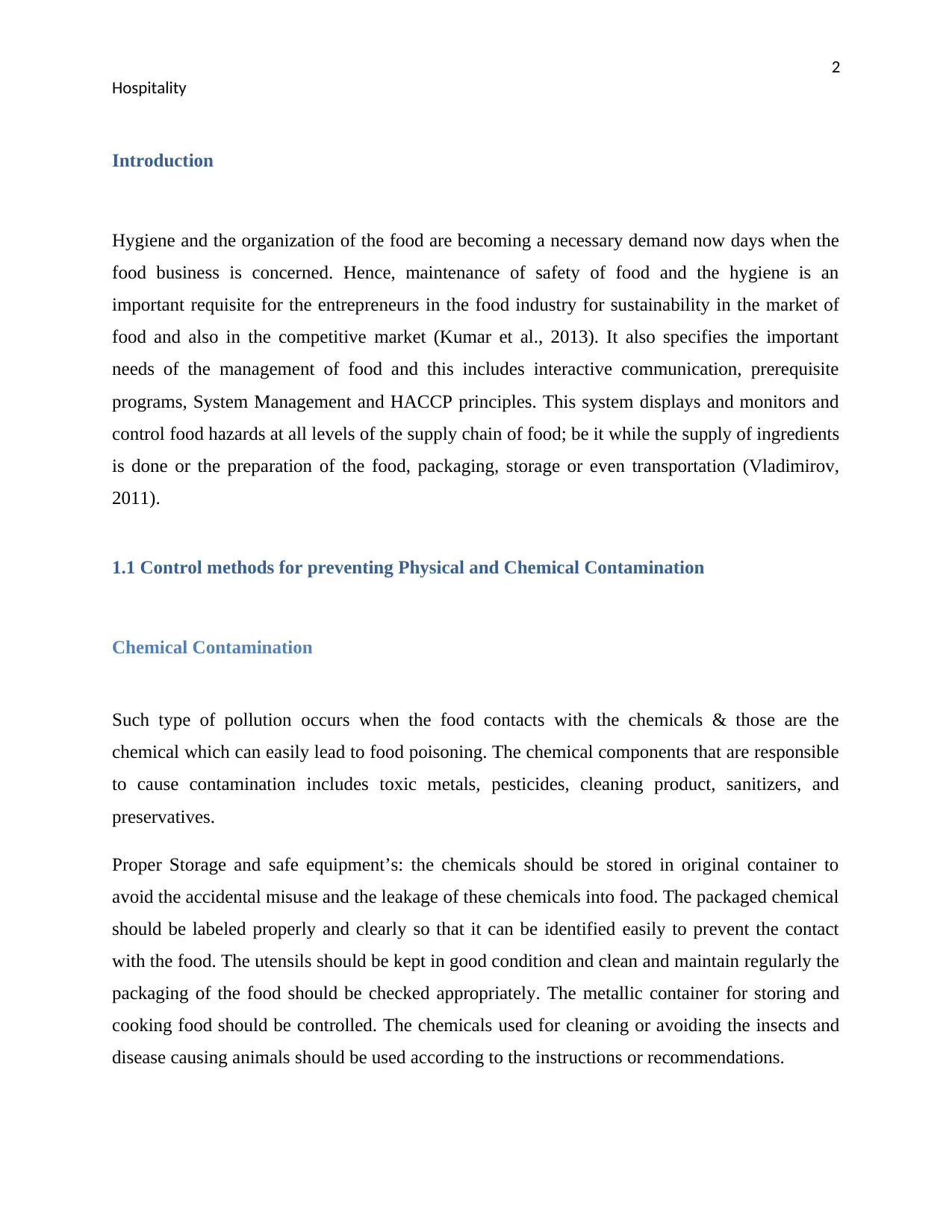
2
Hospitality
Introduction
Hygiene and the organization of the food are becoming a necessary demand now days when the
food business is concerned. Hence, maintenance of safety of food and the hygiene is an
important requisite for the entrepreneurs in the food industry for sustainability in the market of
food and also in the competitive market (Kumar et al., 2013). It also specifies the important
needs of the management of food and this includes interactive communication, prerequisite
programs, System Management and HACCP principles. This system displays and monitors and
control food hazards at all levels of the supply chain of food; be it while the supply of ingredients
is done or the preparation of the food, packaging, storage or even transportation (Vladimirov,
2011).
1.1 Control methods for preventing Physical and Chemical Contamination
Chemical Contamination
Such type of pollution occurs when the food contacts with the chemicals & those are the
chemical which can easily lead to food poisoning. The chemical components that are responsible
to cause contamination includes toxic metals, pesticides, cleaning product, sanitizers, and
preservatives.
Proper Storage and safe equipment’s: the chemicals should be stored in original container to
avoid the accidental misuse and the leakage of these chemicals into food. The packaged chemical
should be labeled properly and clearly so that it can be identified easily to prevent the contact
with the food. The utensils should be kept in good condition and clean and maintain regularly the
packaging of the food should be checked appropriately. The metallic container for storing and
cooking food should be controlled. The chemicals used for cleaning or avoiding the insects and
disease causing animals should be used according to the instructions or recommendations.
Hospitality
Introduction
Hygiene and the organization of the food are becoming a necessary demand now days when the
food business is concerned. Hence, maintenance of safety of food and the hygiene is an
important requisite for the entrepreneurs in the food industry for sustainability in the market of
food and also in the competitive market (Kumar et al., 2013). It also specifies the important
needs of the management of food and this includes interactive communication, prerequisite
programs, System Management and HACCP principles. This system displays and monitors and
control food hazards at all levels of the supply chain of food; be it while the supply of ingredients
is done or the preparation of the food, packaging, storage or even transportation (Vladimirov,
2011).
1.1 Control methods for preventing Physical and Chemical Contamination
Chemical Contamination
Such type of pollution occurs when the food contacts with the chemicals & those are the
chemical which can easily lead to food poisoning. The chemical components that are responsible
to cause contamination includes toxic metals, pesticides, cleaning product, sanitizers, and
preservatives.
Proper Storage and safe equipment’s: the chemicals should be stored in original container to
avoid the accidental misuse and the leakage of these chemicals into food. The packaged chemical
should be labeled properly and clearly so that it can be identified easily to prevent the contact
with the food. The utensils should be kept in good condition and clean and maintain regularly the
packaging of the food should be checked appropriately. The metallic container for storing and
cooking food should be controlled. The chemicals used for cleaning or avoiding the insects and
disease causing animals should be used according to the instructions or recommendations.

3
Hospitality
Proper cooking: food should be washed and cooked properly to eradicate the chemical
substances (pesticides) used during the plant growth (Rather et al., 2017).
Avoid using plastic containers: various studies have been conducted on the toxic compounds
such as Bisphenol A (BPA) that may cause health problem like cancer and obesity. To prevent
chemical contamination the use of plastic container should be limited or stopped. Various plastic
container with label “BPA free” also not safe to use. Items which are singly used like containers
of plastic are not designed for re-usage again. Hence, the food should always be stored in the
containers which are safe to use (Hussain, 2016).
Other preventable measure: some of the aspects should be considered while cooking includes the
sanitizing solutions should be tested regularly, the food should be washed under cold running
water, and hands should be washed properly while processing the food.
Physical Contamination
Food can be contaminated by some physical objects generally named as foreign bodies. This
type of contamination occurs when the real objects help in the pollution of food. There have been
a lot of times when the food is physically contaminated, that time the food is physically
contaminated too (Caraveo et al., 2013). The reason behind this is that the contamination may
store bacteria which are dangerous. Example: Fingernail.
Control required preventing the physical contamination of food:
Hair: The hair should always be neatly tied in a bun while working. Today, many of the hoteliers
use hair cap to tie the bun in order to not let the hair fall into the food.
Metal or Glass: When the kitchen products are not at all maintained like the broken crockery and
utensils, the physical food contamination can occur. Such type of utensils should be thrown out
as soon as they are broken.
Hospitality
Proper cooking: food should be washed and cooked properly to eradicate the chemical
substances (pesticides) used during the plant growth (Rather et al., 2017).
Avoid using plastic containers: various studies have been conducted on the toxic compounds
such as Bisphenol A (BPA) that may cause health problem like cancer and obesity. To prevent
chemical contamination the use of plastic container should be limited or stopped. Various plastic
container with label “BPA free” also not safe to use. Items which are singly used like containers
of plastic are not designed for re-usage again. Hence, the food should always be stored in the
containers which are safe to use (Hussain, 2016).
Other preventable measure: some of the aspects should be considered while cooking includes the
sanitizing solutions should be tested regularly, the food should be washed under cold running
water, and hands should be washed properly while processing the food.
Physical Contamination
Food can be contaminated by some physical objects generally named as foreign bodies. This
type of contamination occurs when the real objects help in the pollution of food. There have been
a lot of times when the food is physically contaminated, that time the food is physically
contaminated too (Caraveo et al., 2013). The reason behind this is that the contamination may
store bacteria which are dangerous. Example: Fingernail.
Control required preventing the physical contamination of food:
Hair: The hair should always be neatly tied in a bun while working. Today, many of the hoteliers
use hair cap to tie the bun in order to not let the hair fall into the food.
Metal or Glass: When the kitchen products are not at all maintained like the broken crockery and
utensils, the physical food contamination can occur. Such type of utensils should be thrown out
as soon as they are broken.
Secure Best Marks with AI Grader
Need help grading? Try our AI Grader for instant feedback on your assignments.
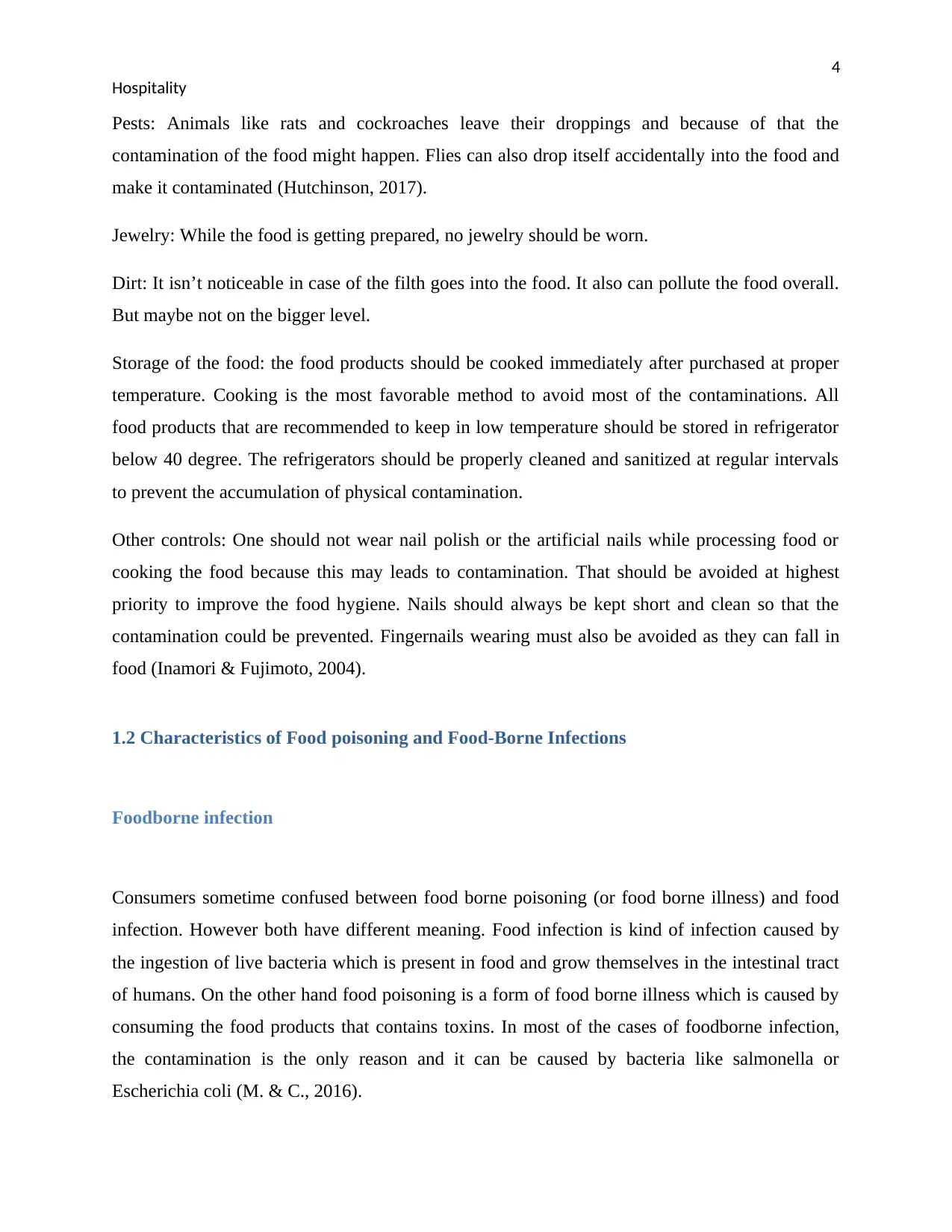
4
Hospitality
Pests: Animals like rats and cockroaches leave their droppings and because of that the
contamination of the food might happen. Flies can also drop itself accidentally into the food and
make it contaminated (Hutchinson, 2017).
Jewelry: While the food is getting prepared, no jewelry should be worn.
Dirt: It isn’t noticeable in case of the filth goes into the food. It also can pollute the food overall.
But maybe not on the bigger level.
Storage of the food: the food products should be cooked immediately after purchased at proper
temperature. Cooking is the most favorable method to avoid most of the contaminations. All
food products that are recommended to keep in low temperature should be stored in refrigerator
below 40 degree. The refrigerators should be properly cleaned and sanitized at regular intervals
to prevent the accumulation of physical contamination.
Other controls: One should not wear nail polish or the artificial nails while processing food or
cooking the food because this may leads to contamination. That should be avoided at highest
priority to improve the food hygiene. Nails should always be kept short and clean so that the
contamination could be prevented. Fingernails wearing must also be avoided as they can fall in
food (Inamori & Fujimoto, 2004).
1.2 Characteristics of Food poisoning and Food-Borne Infections
Foodborne infection
Consumers sometime confused between food borne poisoning (or food borne illness) and food
infection. However both have different meaning. Food infection is kind of infection caused by
the ingestion of live bacteria which is present in food and grow themselves in the intestinal tract
of humans. On the other hand food poisoning is a form of food borne illness which is caused by
consuming the food products that contains toxins. In most of the cases of foodborne infection,
the contamination is the only reason and it can be caused by bacteria like salmonella or
Escherichia coli (M. & C., 2016).
Hospitality
Pests: Animals like rats and cockroaches leave their droppings and because of that the
contamination of the food might happen. Flies can also drop itself accidentally into the food and
make it contaminated (Hutchinson, 2017).
Jewelry: While the food is getting prepared, no jewelry should be worn.
Dirt: It isn’t noticeable in case of the filth goes into the food. It also can pollute the food overall.
But maybe not on the bigger level.
Storage of the food: the food products should be cooked immediately after purchased at proper
temperature. Cooking is the most favorable method to avoid most of the contaminations. All
food products that are recommended to keep in low temperature should be stored in refrigerator
below 40 degree. The refrigerators should be properly cleaned and sanitized at regular intervals
to prevent the accumulation of physical contamination.
Other controls: One should not wear nail polish or the artificial nails while processing food or
cooking the food because this may leads to contamination. That should be avoided at highest
priority to improve the food hygiene. Nails should always be kept short and clean so that the
contamination could be prevented. Fingernails wearing must also be avoided as they can fall in
food (Inamori & Fujimoto, 2004).
1.2 Characteristics of Food poisoning and Food-Borne Infections
Foodborne infection
Consumers sometime confused between food borne poisoning (or food borne illness) and food
infection. However both have different meaning. Food infection is kind of infection caused by
the ingestion of live bacteria which is present in food and grow themselves in the intestinal tract
of humans. On the other hand food poisoning is a form of food borne illness which is caused by
consuming the food products that contains toxins. In most of the cases of foodborne infection,
the contamination is the only reason and it can be caused by bacteria like salmonella or
Escherichia coli (M. & C., 2016).

5
Hospitality
Symptoms of Foodborne infection
The major symptoms of food poisoning involve:
Abdominal pain and cramps
Diarrhea for more than 7 days
Joint/ back aches
Vomiting
fatigue
Fever
Nausea
Dehydration which includes dry mouth, no urine or less (Ogori & Friday, 2014).
Causes of foodborne infection
Bacteria: It is one of the most prevalent causes of poisoning. Some dangerous bacteria are E coli,
Listeria, campylobacter, cryptosporidium, and salmonella (Kunwar et al., 2013).
Parasites: Food poisoning is also caused by the vermin but it is not common as compared the
bacteria. Parasites which are in contaminated food are considered to be very dangerous.
Toxoplasma is the type of parasite which is seen in many of the cases.
Virus: Virus can also be one of the causes. For example, Noro Virus which is also known as
Norwalk Virus is the cause of food poisoning in 19 million cases every year. (Blouw & Embil,
2005).
Causes other than microorganism: When the food is not cooked properly, storage of the food or
its product not stored appropriately, if the food left out for long, the food is handled by someone
who is sick and if the food items is consumed after the expiry date.
Food poisoning
Food poison can be occurs due to the consumption of food contaminated with toxins or the
chemicals which contaminate the food (Hakim et al., 2015). It has become the serious health
Hospitality
Symptoms of Foodborne infection
The major symptoms of food poisoning involve:
Abdominal pain and cramps
Diarrhea for more than 7 days
Joint/ back aches
Vomiting
fatigue
Fever
Nausea
Dehydration which includes dry mouth, no urine or less (Ogori & Friday, 2014).
Causes of foodborne infection
Bacteria: It is one of the most prevalent causes of poisoning. Some dangerous bacteria are E coli,
Listeria, campylobacter, cryptosporidium, and salmonella (Kunwar et al., 2013).
Parasites: Food poisoning is also caused by the vermin but it is not common as compared the
bacteria. Parasites which are in contaminated food are considered to be very dangerous.
Toxoplasma is the type of parasite which is seen in many of the cases.
Virus: Virus can also be one of the causes. For example, Noro Virus which is also known as
Norwalk Virus is the cause of food poisoning in 19 million cases every year. (Blouw & Embil,
2005).
Causes other than microorganism: When the food is not cooked properly, storage of the food or
its product not stored appropriately, if the food left out for long, the food is handled by someone
who is sick and if the food items is consumed after the expiry date.
Food poisoning
Food poison can be occurs due to the consumption of food contaminated with toxins or the
chemicals which contaminate the food (Hakim et al., 2015). It has become the serious health

6
Hospitality
issues which have affected people from all over the world. According to Centers for disease
control and prevention, each year one in six people in America suffer with some form of food
poisoning (Center for disease control and prevention, 2017).
Food poisoning is the form of foodborne illness and that is why they do have more or less similar
symptoms.
Symptoms of Food poisoning
The symptoms of food poisoning are more similar to the symptoms associated with foodborne
infections. Such as
Diarrhea
Vomiting more than 7 days
Loss of appetite
Fever
weakness
Stomach infection can also happen in foodborne infections (Addis & Sisay, 2015).
Causes of foodborne infections
There are several causes which make foodborne disease to occur. They are:
Raw and undercooked poultry products like chicken, duck and turkey has the high risk of
developing food poisoning
Vegetables and leafy greens are the common source of food poisoning. Leafy greens are
more likely to cause health issues because they generally consumes raw.
Food contamination can be occurring from dirty processing equipment and the
unhygienic food preparation practices.
The fish and fish products that are not stored at the recommended temperature are ore
likely to be contaminated with a toxin known as histamine which is produced by the
bacteria in fish. Shellfish like clams and oysters also have higher risk of causing food
poisoning. Algae consumed by shellfish produce many toxins, when these shellfish eaten
by human they may cause food poisoning.
Hospitality
issues which have affected people from all over the world. According to Centers for disease
control and prevention, each year one in six people in America suffer with some form of food
poisoning (Center for disease control and prevention, 2017).
Food poisoning is the form of foodborne illness and that is why they do have more or less similar
symptoms.
Symptoms of Food poisoning
The symptoms of food poisoning are more similar to the symptoms associated with foodborne
infections. Such as
Diarrhea
Vomiting more than 7 days
Loss of appetite
Fever
weakness
Stomach infection can also happen in foodborne infections (Addis & Sisay, 2015).
Causes of foodborne infections
There are several causes which make foodborne disease to occur. They are:
Raw and undercooked poultry products like chicken, duck and turkey has the high risk of
developing food poisoning
Vegetables and leafy greens are the common source of food poisoning. Leafy greens are
more likely to cause health issues because they generally consumes raw.
Food contamination can be occurring from dirty processing equipment and the
unhygienic food preparation practices.
The fish and fish products that are not stored at the recommended temperature are ore
likely to be contaminated with a toxin known as histamine which is produced by the
bacteria in fish. Shellfish like clams and oysters also have higher risk of causing food
poisoning. Algae consumed by shellfish produce many toxins, when these shellfish eaten
by human they may cause food poisoning.
Paraphrase This Document
Need a fresh take? Get an instant paraphrase of this document with our AI Paraphraser

7
Hospitality
Food poisoning can also be caused by consuming unpasteurized dairy product (Coyle,
2018).
1.3 Control Measures of Food Borne Illness
Measures from which this infection can be controlled are as follows:
HACCP Plan: This is a type of written plan which defines the process of managing the
control of probable hazardous food that is at the critical control points of preparation of
food processing. If Put Simply, it is a plan displaying as to how food is handled so
consumers won't get sick (Sagepub, 2014).
Personal Hygiene: Human beings should keep the personal hygiene so that the bacteria
which can cause food poisoning to be reduced or mitigated. Human beings can do certain
things like they can wash their hands after visiting the washroom, at the time of
preparation of food, in between working with the raw vegetables and ready to eat foods,
in between raw species like pork, chicken, seafood and also after engaging in some other
activities which can contaminate hands.
Cleaning Measures: If no samples are needed for the laboratory testing, the surfaces of
the food service establishment must be cleaned and not infected for preventing the
probability of the cross-contamination. The surfaces where the food touches like door
handles, hand wash stations and wait for areas etc. should be kept especially clean. The
beach water of chlorine is impactful for disinfection in a huge variety of the surfaces.
Temperature Control: The time of monitoring and controlled temperature of food records
controls probably hazardous foods specified in 15ANCAC 18A .2600. Records must be
made available for the review by local environmental health program at the request.
Storage Temperature: The hard work is done for estimating the processing of food at the
time in which food implicated is being developed. The temperature of the food at the time
of processing and storage must always be measured for the good quality food (Khatoon et
al., 2017).
Training measures: the World Health Organization encourages the adaption of the global
health messaged on the local level. The projects which are educational are being
implemented at the level of the community. The training programs are translated into 30
Hospitality
Food poisoning can also be caused by consuming unpasteurized dairy product (Coyle,
2018).
1.3 Control Measures of Food Borne Illness
Measures from which this infection can be controlled are as follows:
HACCP Plan: This is a type of written plan which defines the process of managing the
control of probable hazardous food that is at the critical control points of preparation of
food processing. If Put Simply, it is a plan displaying as to how food is handled so
consumers won't get sick (Sagepub, 2014).
Personal Hygiene: Human beings should keep the personal hygiene so that the bacteria
which can cause food poisoning to be reduced or mitigated. Human beings can do certain
things like they can wash their hands after visiting the washroom, at the time of
preparation of food, in between working with the raw vegetables and ready to eat foods,
in between raw species like pork, chicken, seafood and also after engaging in some other
activities which can contaminate hands.
Cleaning Measures: If no samples are needed for the laboratory testing, the surfaces of
the food service establishment must be cleaned and not infected for preventing the
probability of the cross-contamination. The surfaces where the food touches like door
handles, hand wash stations and wait for areas etc. should be kept especially clean. The
beach water of chlorine is impactful for disinfection in a huge variety of the surfaces.
Temperature Control: The time of monitoring and controlled temperature of food records
controls probably hazardous foods specified in 15ANCAC 18A .2600. Records must be
made available for the review by local environmental health program at the request.
Storage Temperature: The hard work is done for estimating the processing of food at the
time in which food implicated is being developed. The temperature of the food at the time
of processing and storage must always be measured for the good quality food (Khatoon et
al., 2017).
Training measures: the World Health Organization encourages the adaption of the global
health messaged on the local level. The projects which are educational are being
implemented at the level of the community. The training programs are translated into 30
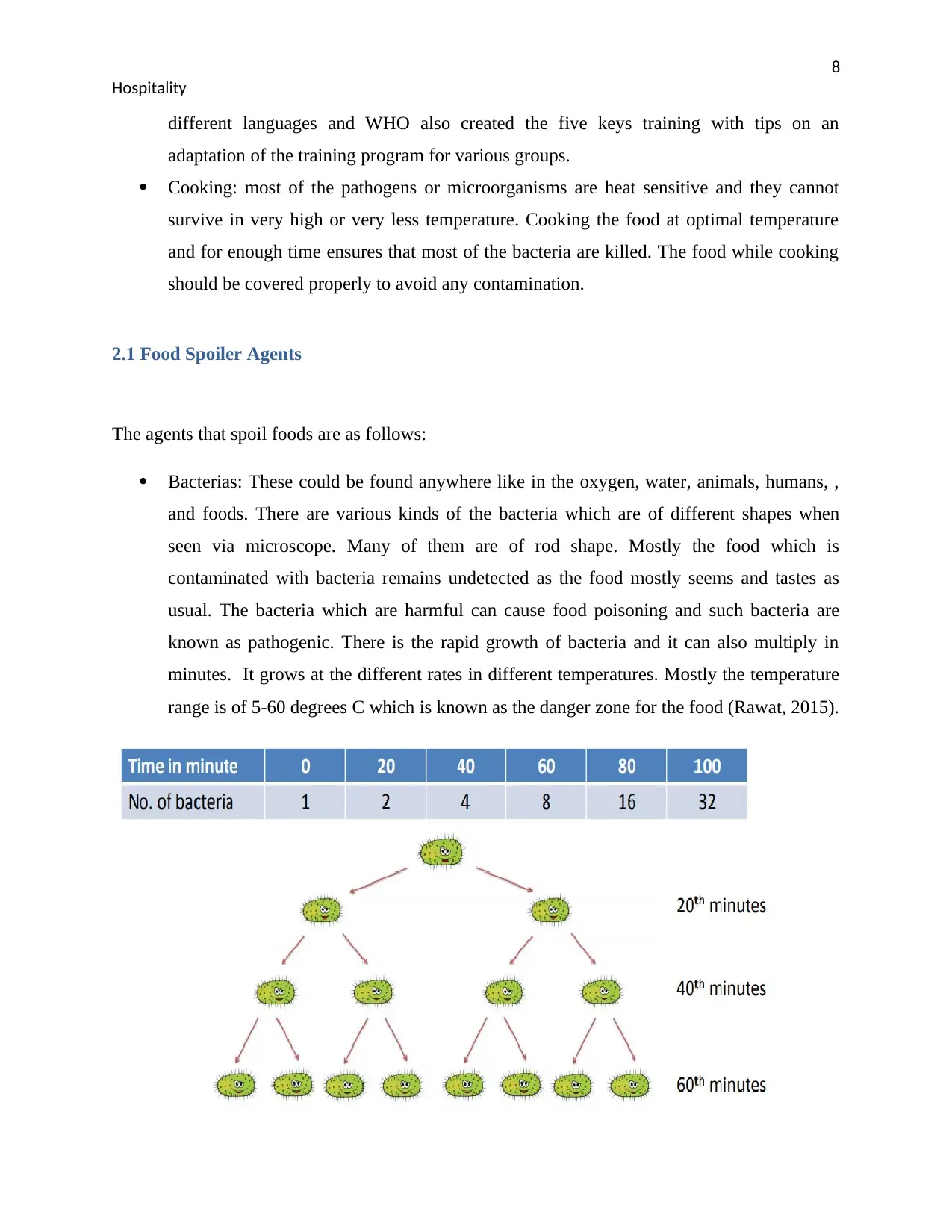
8
Hospitality
different languages and WHO also created the five keys training with tips on an
adaptation of the training program for various groups.
Cooking: most of the pathogens or microorganisms are heat sensitive and they cannot
survive in very high or very less temperature. Cooking the food at optimal temperature
and for enough time ensures that most of the bacteria are killed. The food while cooking
should be covered properly to avoid any contamination.
2.1 Food Spoiler Agents
The agents that spoil foods are as follows:
Bacterias: These could be found anywhere like in the oxygen, water, animals, humans, ,
and foods. There are various kinds of the bacteria which are of different shapes when
seen via microscope. Many of them are of rod shape. Mostly the food which is
contaminated with bacteria remains undetected as the food mostly seems and tastes as
usual. The bacteria which are harmful can cause food poisoning and such bacteria are
known as pathogenic. There is the rapid growth of bacteria and it can also multiply in
minutes. It grows at the different rates in different temperatures. Mostly the temperature
range is of 5-60 degrees C which is known as the danger zone for the food (Rawat, 2015).
Hospitality
different languages and WHO also created the five keys training with tips on an
adaptation of the training program for various groups.
Cooking: most of the pathogens or microorganisms are heat sensitive and they cannot
survive in very high or very less temperature. Cooking the food at optimal temperature
and for enough time ensures that most of the bacteria are killed. The food while cooking
should be covered properly to avoid any contamination.
2.1 Food Spoiler Agents
The agents that spoil foods are as follows:
Bacterias: These could be found anywhere like in the oxygen, water, animals, humans, ,
and foods. There are various kinds of the bacteria which are of different shapes when
seen via microscope. Many of them are of rod shape. Mostly the food which is
contaminated with bacteria remains undetected as the food mostly seems and tastes as
usual. The bacteria which are harmful can cause food poisoning and such bacteria are
known as pathogenic. There is the rapid growth of bacteria and it can also multiply in
minutes. It grows at the different rates in different temperatures. Mostly the temperature
range is of 5-60 degrees C which is known as the danger zone for the food (Rawat, 2015).
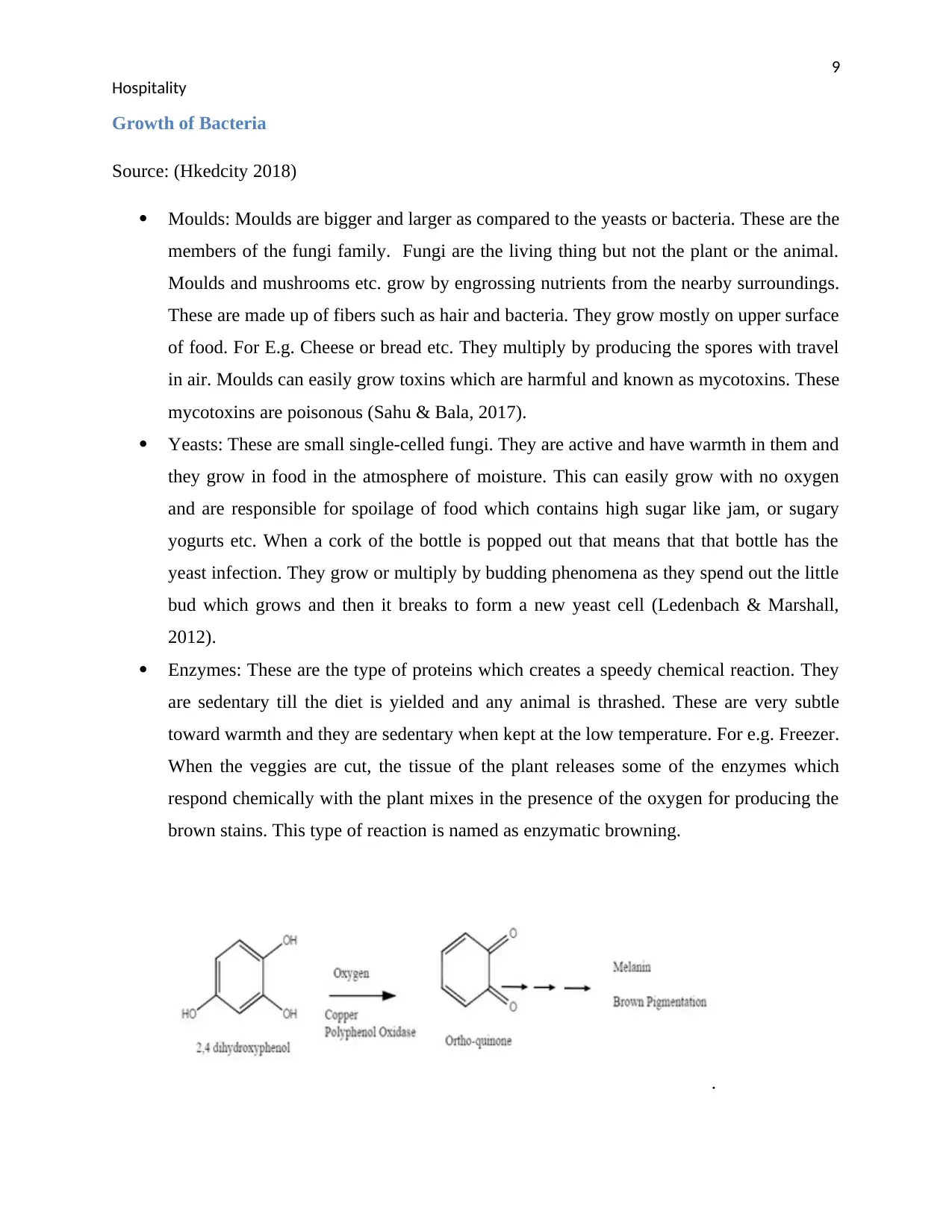
9
Hospitality
Growth of Bacteria
Source: (Hkedcity 2018)
Moulds: Moulds are bigger and larger as compared to the yeasts or bacteria. These are the
members of the fungi family. Fungi are the living thing but not the plant or the animal.
Moulds and mushrooms etc. grow by engrossing nutrients from the nearby surroundings.
These are made up of fibers such as hair and bacteria. They grow mostly on upper surface
of food. For E.g. Cheese or bread etc. They multiply by producing the spores with travel
in air. Moulds can easily grow toxins which are harmful and known as mycotoxins. These
mycotoxins are poisonous (Sahu & Bala, 2017).
Yeasts: These are small single-celled fungi. They are active and have warmth in them and
they grow in food in the atmosphere of moisture. This can easily grow with no oxygen
and are responsible for spoilage of food which contains high sugar like jam, or sugary
yogurts etc. When a cork of the bottle is popped out that means that that bottle has the
yeast infection. They grow or multiply by budding phenomena as they spend out the little
bud which grows and then it breaks to form a new yeast cell (Ledenbach & Marshall,
2012).
Enzymes: These are the type of proteins which creates a speedy chemical reaction. They
are sedentary till the diet is yielded and any animal is thrashed. These are very subtle
toward warmth and they are sedentary when kept at the low temperature. For e.g. Freezer.
When the veggies are cut, the tissue of the plant releases some of the enzymes which
respond chemically with the plant mixes in the presence of the oxygen for producing the
brown stains. This type of reaction is named as enzymatic browning.
.
Hospitality
Growth of Bacteria
Source: (Hkedcity 2018)
Moulds: Moulds are bigger and larger as compared to the yeasts or bacteria. These are the
members of the fungi family. Fungi are the living thing but not the plant or the animal.
Moulds and mushrooms etc. grow by engrossing nutrients from the nearby surroundings.
These are made up of fibers such as hair and bacteria. They grow mostly on upper surface
of food. For E.g. Cheese or bread etc. They multiply by producing the spores with travel
in air. Moulds can easily grow toxins which are harmful and known as mycotoxins. These
mycotoxins are poisonous (Sahu & Bala, 2017).
Yeasts: These are small single-celled fungi. They are active and have warmth in them and
they grow in food in the atmosphere of moisture. This can easily grow with no oxygen
and are responsible for spoilage of food which contains high sugar like jam, or sugary
yogurts etc. When a cork of the bottle is popped out that means that that bottle has the
yeast infection. They grow or multiply by budding phenomena as they spend out the little
bud which grows and then it breaks to form a new yeast cell (Ledenbach & Marshall,
2012).
Enzymes: These are the type of proteins which creates a speedy chemical reaction. They
are sedentary till the diet is yielded and any animal is thrashed. These are very subtle
toward warmth and they are sedentary when kept at the low temperature. For e.g. Freezer.
When the veggies are cut, the tissue of the plant releases some of the enzymes which
respond chemically with the plant mixes in the presence of the oxygen for producing the
brown stains. This type of reaction is named as enzymatic browning.
.
Secure Best Marks with AI Grader
Need help grading? Try our AI Grader for instant feedback on your assignments.
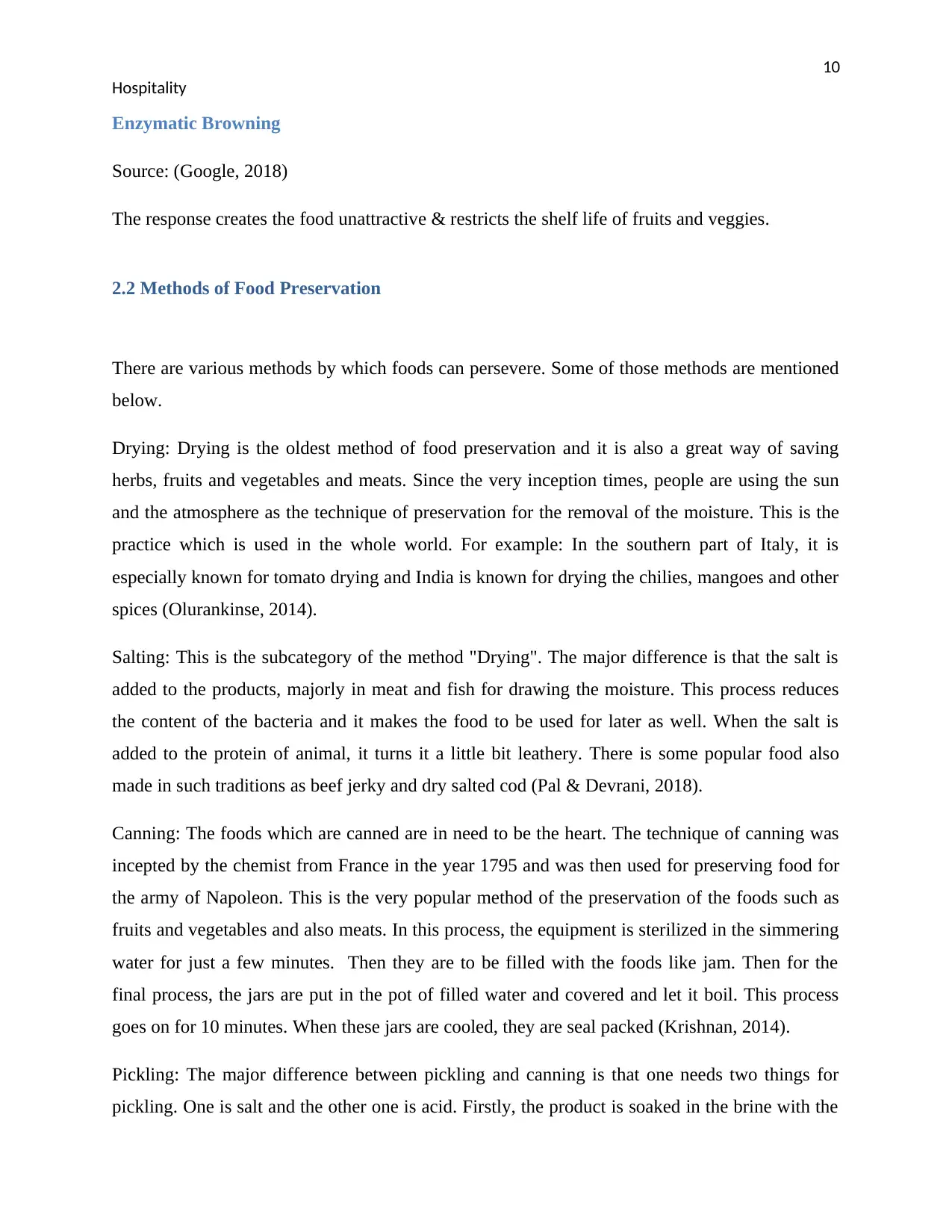
10
Hospitality
Enzymatic Browning
Source: (Google, 2018)
The response creates the food unattractive & restricts the shelf life of fruits and veggies.
2.2 Methods of Food Preservation
There are various methods by which foods can persevere. Some of those methods are mentioned
below.
Drying: Drying is the oldest method of food preservation and it is also a great way of saving
herbs, fruits and vegetables and meats. Since the very inception times, people are using the sun
and the atmosphere as the technique of preservation for the removal of the moisture. This is the
practice which is used in the whole world. For example: In the southern part of Italy, it is
especially known for tomato drying and India is known for drying the chilies, mangoes and other
spices (Olurankinse, 2014).
Salting: This is the subcategory of the method "Drying". The major difference is that the salt is
added to the products, majorly in meat and fish for drawing the moisture. This process reduces
the content of the bacteria and it makes the food to be used for later as well. When the salt is
added to the protein of animal, it turns it a little bit leathery. There is some popular food also
made in such traditions as beef jerky and dry salted cod (Pal & Devrani, 2018).
Canning: The foods which are canned are in need to be the heart. The technique of canning was
incepted by the chemist from France in the year 1795 and was then used for preserving food for
the army of Napoleon. This is the very popular method of the preservation of the foods such as
fruits and vegetables and also meats. In this process, the equipment is sterilized in the simmering
water for just a few minutes. Then they are to be filled with the foods like jam. Then for the
final process, the jars are put in the pot of filled water and covered and let it boil. This process
goes on for 10 minutes. When these jars are cooled, they are seal packed (Krishnan, 2014).
Pickling: The major difference between pickling and canning is that one needs two things for
pickling. One is salt and the other one is acid. Firstly, the product is soaked in the brine with the
Hospitality
Enzymatic Browning
Source: (Google, 2018)
The response creates the food unattractive & restricts the shelf life of fruits and veggies.
2.2 Methods of Food Preservation
There are various methods by which foods can persevere. Some of those methods are mentioned
below.
Drying: Drying is the oldest method of food preservation and it is also a great way of saving
herbs, fruits and vegetables and meats. Since the very inception times, people are using the sun
and the atmosphere as the technique of preservation for the removal of the moisture. This is the
practice which is used in the whole world. For example: In the southern part of Italy, it is
especially known for tomato drying and India is known for drying the chilies, mangoes and other
spices (Olurankinse, 2014).
Salting: This is the subcategory of the method "Drying". The major difference is that the salt is
added to the products, majorly in meat and fish for drawing the moisture. This process reduces
the content of the bacteria and it makes the food to be used for later as well. When the salt is
added to the protein of animal, it turns it a little bit leathery. There is some popular food also
made in such traditions as beef jerky and dry salted cod (Pal & Devrani, 2018).
Canning: The foods which are canned are in need to be the heart. The technique of canning was
incepted by the chemist from France in the year 1795 and was then used for preserving food for
the army of Napoleon. This is the very popular method of the preservation of the foods such as
fruits and vegetables and also meats. In this process, the equipment is sterilized in the simmering
water for just a few minutes. Then they are to be filled with the foods like jam. Then for the
final process, the jars are put in the pot of filled water and covered and let it boil. This process
goes on for 10 minutes. When these jars are cooled, they are seal packed (Krishnan, 2014).
Pickling: The major difference between pickling and canning is that one needs two things for
pickling. One is salt and the other one is acid. Firstly, the product is soaked in the brine with the

11
Hospitality
salt. When the salt is picked up in particular enough amounts, it is shifted to the jar which is
filled with Vinegar. This is the time when the canning methods are used.
Refrigeration: This process works on the basis of the principle that the activity of the bacteria
and enzyme are kept on the temperature which is fairly low. This can be applied to the perishable
goods like milk, fruits, veggies etc. The refrigerator is also set on the particular temperature and
goes into action when there is a rise in the temperature. Foods are to be covered to be free from
the moisture. Covering the foods will also avoid the flavor picking from other foods. They
should be wrapped with cellophane or aluminum foil.
Freezing: In this method, bacteria's are not able to develop and grow and also the enzymes are
not activated. The food which is frozen always contains bacteria and enzymes which lies in the
latent state and that is why it is necessary for the food to be at a temperature of 18 degrees
Celsius. The multiplication in the bacteria and enzymes happen for bringing oxidative changes as
soon as food begins to defrost.
Sugaring: Sugar helps in preparing the jam, jellies and other food. They all have a high quality of
foods. Water is not made available to the microorganism and hence, food will not spoil.
Although, mould might grow on the surface of the food in case of the sterility is not managed.
Pasteurization: It is the process of the processing of the heating of the liquid or food for killing
the bacteria named pathogenic in order to make the food safe for eating. By doing this the
bacteria will be killed and it will help in reducing the disease to be transmitted like fever,
tuberculosis, polio etc. It is significant that foods might get contaminated even when they go
through this process.
Sterilization: In this process, this is done with the moist heat and the temperature should
generally be at 110 to 130 C with the timing of 20 to 40 min. Example: The foods which are
canned should be sterilized in the autoclave at about 1210C for 20 min.
UHT Treatment: HT means a significantly very small treatment which is done at the temperature
of approximately 1400C for very few seconds. This will result in the negligible heat injury for
the product possessions. Hence the product is sterilized before it gets transferred to pre-sterilized
jars in the atmosphere which is sterile (Living, 2009).
Hospitality
salt. When the salt is picked up in particular enough amounts, it is shifted to the jar which is
filled with Vinegar. This is the time when the canning methods are used.
Refrigeration: This process works on the basis of the principle that the activity of the bacteria
and enzyme are kept on the temperature which is fairly low. This can be applied to the perishable
goods like milk, fruits, veggies etc. The refrigerator is also set on the particular temperature and
goes into action when there is a rise in the temperature. Foods are to be covered to be free from
the moisture. Covering the foods will also avoid the flavor picking from other foods. They
should be wrapped with cellophane or aluminum foil.
Freezing: In this method, bacteria's are not able to develop and grow and also the enzymes are
not activated. The food which is frozen always contains bacteria and enzymes which lies in the
latent state and that is why it is necessary for the food to be at a temperature of 18 degrees
Celsius. The multiplication in the bacteria and enzymes happen for bringing oxidative changes as
soon as food begins to defrost.
Sugaring: Sugar helps in preparing the jam, jellies and other food. They all have a high quality of
foods. Water is not made available to the microorganism and hence, food will not spoil.
Although, mould might grow on the surface of the food in case of the sterility is not managed.
Pasteurization: It is the process of the processing of the heating of the liquid or food for killing
the bacteria named pathogenic in order to make the food safe for eating. By doing this the
bacteria will be killed and it will help in reducing the disease to be transmitted like fever,
tuberculosis, polio etc. It is significant that foods might get contaminated even when they go
through this process.
Sterilization: In this process, this is done with the moist heat and the temperature should
generally be at 110 to 130 C with the timing of 20 to 40 min. Example: The foods which are
canned should be sterilized in the autoclave at about 1210C for 20 min.
UHT Treatment: HT means a significantly very small treatment which is done at the temperature
of approximately 1400C for very few seconds. This will result in the negligible heat injury for
the product possessions. Hence the product is sterilized before it gets transferred to pre-sterilized
jars in the atmosphere which is sterile (Living, 2009).
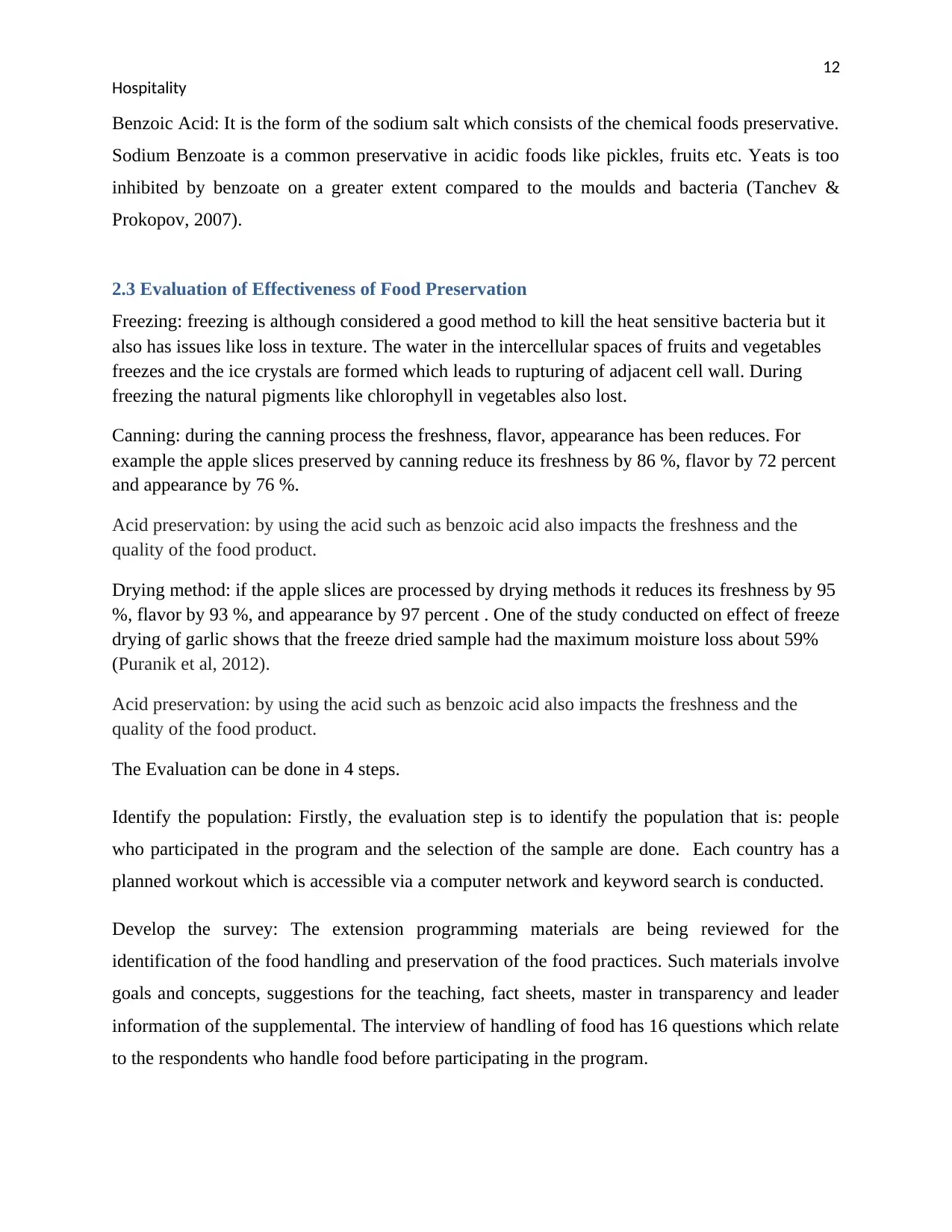
12
Hospitality
Benzoic Acid: It is the form of the sodium salt which consists of the chemical foods preservative.
Sodium Benzoate is a common preservative in acidic foods like pickles, fruits etc. Yeats is too
inhibited by benzoate on a greater extent compared to the moulds and bacteria (Tanchev &
Prokopov, 2007).
2.3 Evaluation of Effectiveness of Food Preservation
Freezing: freezing is although considered a good method to kill the heat sensitive bacteria but it
also has issues like loss in texture. The water in the intercellular spaces of fruits and vegetables
freezes and the ice crystals are formed which leads to rupturing of adjacent cell wall. During
freezing the natural pigments like chlorophyll in vegetables also lost.
Canning: during the canning process the freshness, flavor, appearance has been reduces. For
example the apple slices preserved by canning reduce its freshness by 86 %, flavor by 72 percent
and appearance by 76 %.
Acid preservation: by using the acid such as benzoic acid also impacts the freshness and the
quality of the food product.
Drying method: if the apple slices are processed by drying methods it reduces its freshness by 95
%, flavor by 93 %, and appearance by 97 percent . One of the study conducted on effect of freeze
drying of garlic shows that the freeze dried sample had the maximum moisture loss about 59%
(Puranik et al, 2012).
Acid preservation: by using the acid such as benzoic acid also impacts the freshness and the
quality of the food product.
The Evaluation can be done in 4 steps.
Identify the population: Firstly, the evaluation step is to identify the population that is: people
who participated in the program and the selection of the sample are done. Each country has a
planned workout which is accessible via a computer network and keyword search is conducted.
Develop the survey: The extension programming materials are being reviewed for the
identification of the food handling and preservation of the food practices. Such materials involve
goals and concepts, suggestions for the teaching, fact sheets, master in transparency and leader
information of the supplemental. The interview of handling of food has 16 questions which relate
to the respondents who handle food before participating in the program.
Hospitality
Benzoic Acid: It is the form of the sodium salt which consists of the chemical foods preservative.
Sodium Benzoate is a common preservative in acidic foods like pickles, fruits etc. Yeats is too
inhibited by benzoate on a greater extent compared to the moulds and bacteria (Tanchev &
Prokopov, 2007).
2.3 Evaluation of Effectiveness of Food Preservation
Freezing: freezing is although considered a good method to kill the heat sensitive bacteria but it
also has issues like loss in texture. The water in the intercellular spaces of fruits and vegetables
freezes and the ice crystals are formed which leads to rupturing of adjacent cell wall. During
freezing the natural pigments like chlorophyll in vegetables also lost.
Canning: during the canning process the freshness, flavor, appearance has been reduces. For
example the apple slices preserved by canning reduce its freshness by 86 %, flavor by 72 percent
and appearance by 76 %.
Acid preservation: by using the acid such as benzoic acid also impacts the freshness and the
quality of the food product.
Drying method: if the apple slices are processed by drying methods it reduces its freshness by 95
%, flavor by 93 %, and appearance by 97 percent . One of the study conducted on effect of freeze
drying of garlic shows that the freeze dried sample had the maximum moisture loss about 59%
(Puranik et al, 2012).
Acid preservation: by using the acid such as benzoic acid also impacts the freshness and the
quality of the food product.
The Evaluation can be done in 4 steps.
Identify the population: Firstly, the evaluation step is to identify the population that is: people
who participated in the program and the selection of the sample are done. Each country has a
planned workout which is accessible via a computer network and keyword search is conducted.
Develop the survey: The extension programming materials are being reviewed for the
identification of the food handling and preservation of the food practices. Such materials involve
goals and concepts, suggestions for the teaching, fact sheets, master in transparency and leader
information of the supplemental. The interview of handling of food has 16 questions which relate
to the respondents who handle food before participating in the program.
Paraphrase This Document
Need a fresh take? Get an instant paraphrase of this document with our AI Paraphraser
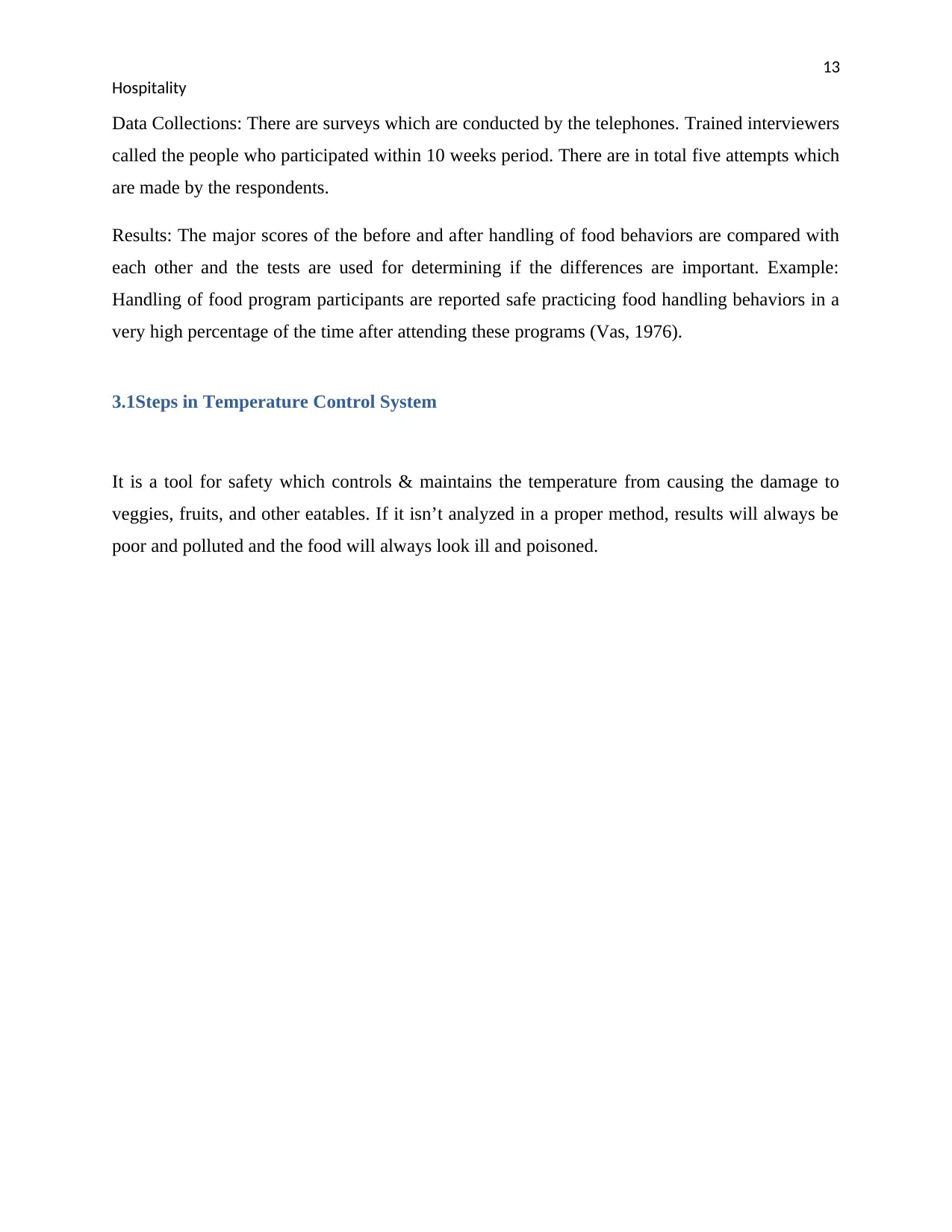
13
Hospitality
Data Collections: There are surveys which are conducted by the telephones. Trained interviewers
called the people who participated within 10 weeks period. There are in total five attempts which
are made by the respondents.
Results: The major scores of the before and after handling of food behaviors are compared with
each other and the tests are used for determining if the differences are important. Example:
Handling of food program participants are reported safe practicing food handling behaviors in a
very high percentage of the time after attending these programs (Vas, 1976).
3.1Steps in Temperature Control System
It is a tool for safety which controls & maintains the temperature from causing the damage to
veggies, fruits, and other eatables. If it isn’t analyzed in a proper method, results will always be
poor and polluted and the food will always look ill and poisoned.
Hospitality
Data Collections: There are surveys which are conducted by the telephones. Trained interviewers
called the people who participated within 10 weeks period. There are in total five attempts which
are made by the respondents.
Results: The major scores of the before and after handling of food behaviors are compared with
each other and the tests are used for determining if the differences are important. Example:
Handling of food program participants are reported safe practicing food handling behaviors in a
very high percentage of the time after attending these programs (Vas, 1976).
3.1Steps in Temperature Control System
It is a tool for safety which controls & maintains the temperature from causing the damage to
veggies, fruits, and other eatables. If it isn’t analyzed in a proper method, results will always be
poor and polluted and the food will always look ill and poisoned.
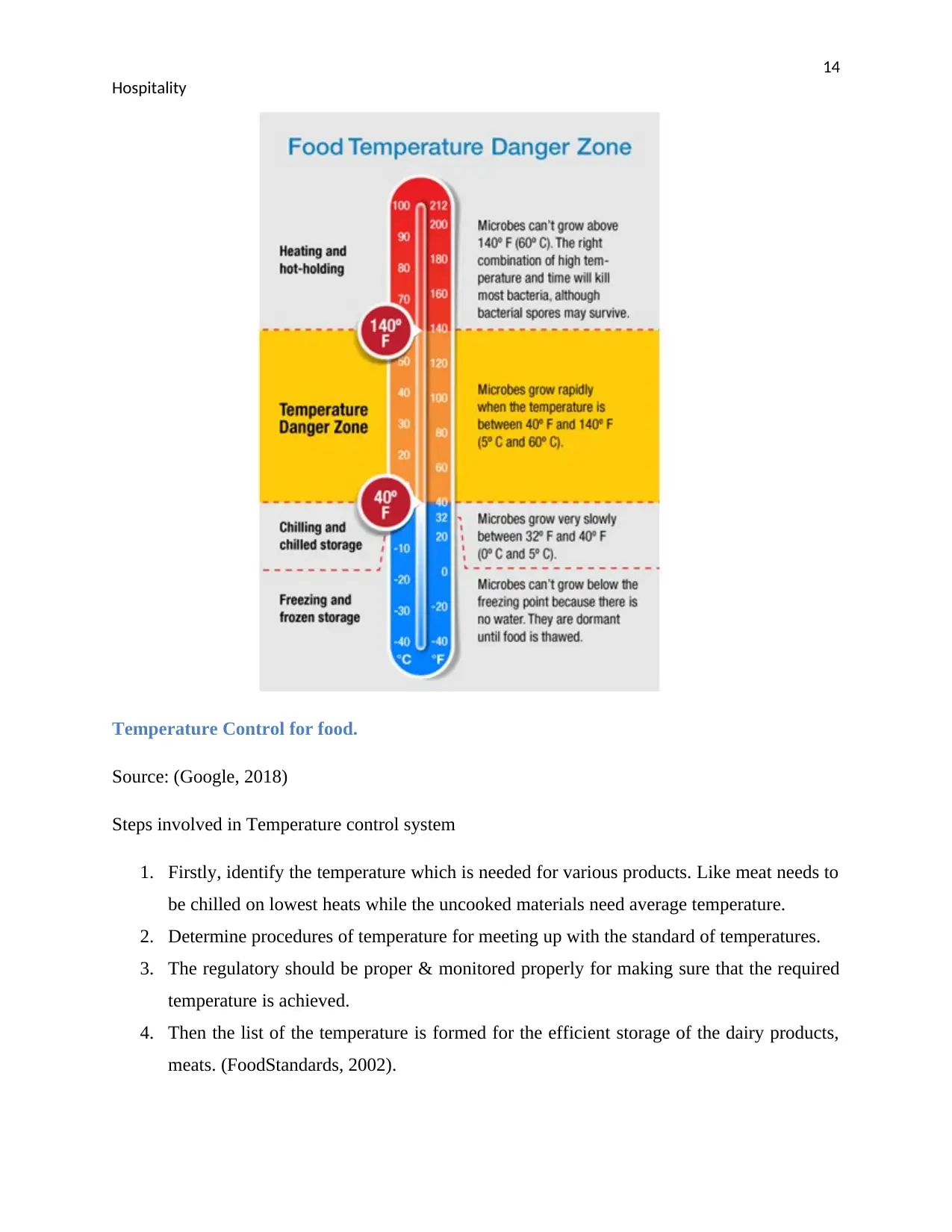
14
Hospitality
Temperature Control for food.
Source: (Google, 2018)
Steps involved in Temperature control system
1. Firstly, identify the temperature which is needed for various products. Like meat needs to
be chilled on lowest heats while the uncooked materials need average temperature.
2. Determine procedures of temperature for meeting up with the standard of temperatures.
3. The regulatory should be proper & monitored properly for making sure that the required
temperature is achieved.
4. Then the list of the temperature is formed for the efficient storage of the dairy products,
meats. (FoodStandards, 2002).
Hospitality
Temperature Control for food.
Source: (Google, 2018)
Steps involved in Temperature control system
1. Firstly, identify the temperature which is needed for various products. Like meat needs to
be chilled on lowest heats while the uncooked materials need average temperature.
2. Determine procedures of temperature for meeting up with the standard of temperatures.
3. The regulatory should be proper & monitored properly for making sure that the required
temperature is achieved.
4. Then the list of the temperature is formed for the efficient storage of the dairy products,
meats. (FoodStandards, 2002).
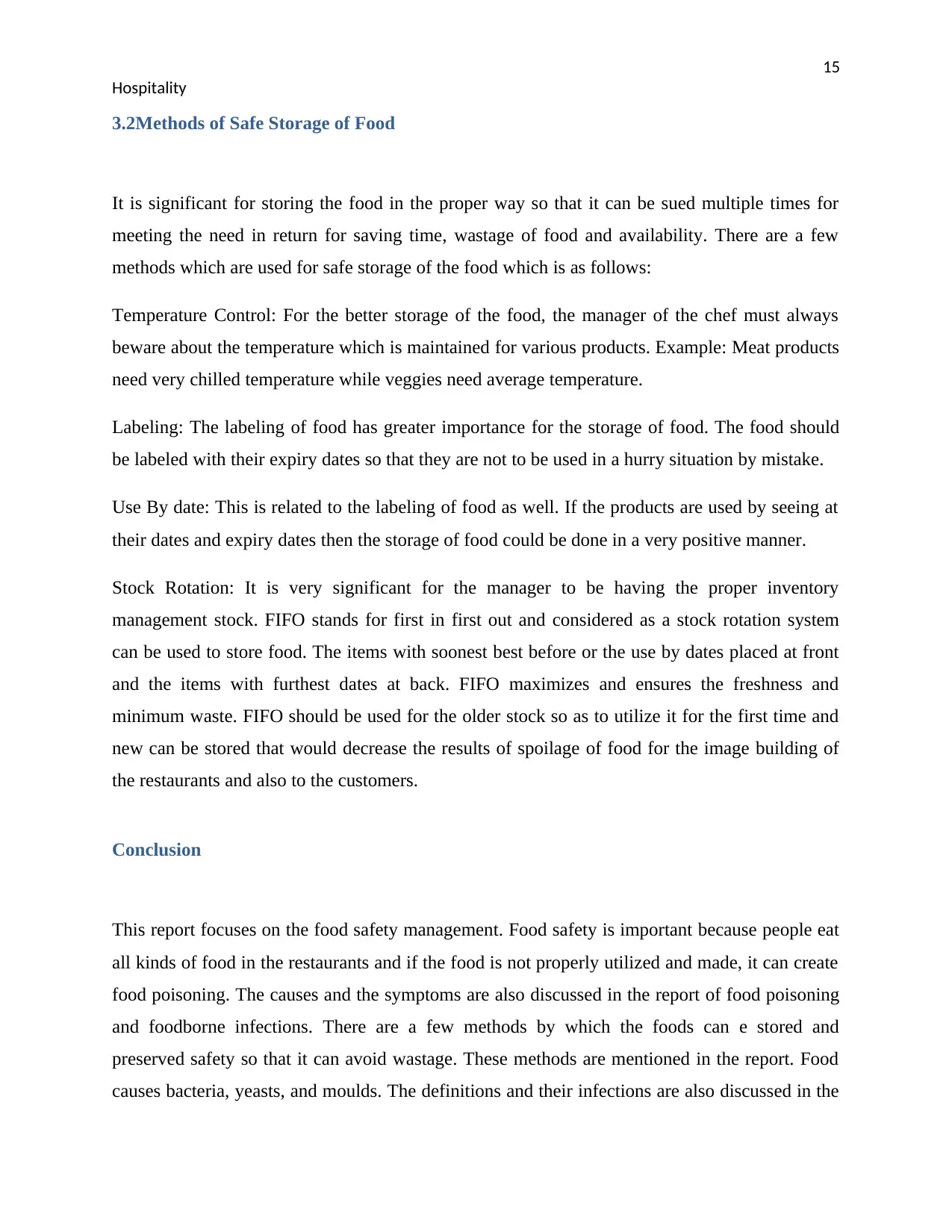
15
Hospitality
3.2Methods of Safe Storage of Food
It is significant for storing the food in the proper way so that it can be sued multiple times for
meeting the need in return for saving time, wastage of food and availability. There are a few
methods which are used for safe storage of the food which is as follows:
Temperature Control: For the better storage of the food, the manager of the chef must always
beware about the temperature which is maintained for various products. Example: Meat products
need very chilled temperature while veggies need average temperature.
Labeling: The labeling of food has greater importance for the storage of food. The food should
be labeled with their expiry dates so that they are not to be used in a hurry situation by mistake.
Use By date: This is related to the labeling of food as well. If the products are used by seeing at
their dates and expiry dates then the storage of food could be done in a very positive manner.
Stock Rotation: It is very significant for the manager to be having the proper inventory
management stock. FIFO stands for first in first out and considered as a stock rotation system
can be used to store food. The items with soonest best before or the use by dates placed at front
and the items with furthest dates at back. FIFO maximizes and ensures the freshness and
minimum waste. FIFO should be used for the older stock so as to utilize it for the first time and
new can be stored that would decrease the results of spoilage of food for the image building of
the restaurants and also to the customers.
Conclusion
This report focuses on the food safety management. Food safety is important because people eat
all kinds of food in the restaurants and if the food is not properly utilized and made, it can create
food poisoning. The causes and the symptoms are also discussed in the report of food poisoning
and foodborne infections. There are a few methods by which the foods can e stored and
preserved safety so that it can avoid wastage. These methods are mentioned in the report. Food
causes bacteria, yeasts, and moulds. The definitions and their infections are also discussed in the
Hospitality
3.2Methods of Safe Storage of Food
It is significant for storing the food in the proper way so that it can be sued multiple times for
meeting the need in return for saving time, wastage of food and availability. There are a few
methods which are used for safe storage of the food which is as follows:
Temperature Control: For the better storage of the food, the manager of the chef must always
beware about the temperature which is maintained for various products. Example: Meat products
need very chilled temperature while veggies need average temperature.
Labeling: The labeling of food has greater importance for the storage of food. The food should
be labeled with their expiry dates so that they are not to be used in a hurry situation by mistake.
Use By date: This is related to the labeling of food as well. If the products are used by seeing at
their dates and expiry dates then the storage of food could be done in a very positive manner.
Stock Rotation: It is very significant for the manager to be having the proper inventory
management stock. FIFO stands for first in first out and considered as a stock rotation system
can be used to store food. The items with soonest best before or the use by dates placed at front
and the items with furthest dates at back. FIFO maximizes and ensures the freshness and
minimum waste. FIFO should be used for the older stock so as to utilize it for the first time and
new can be stored that would decrease the results of spoilage of food for the image building of
the restaurants and also to the customers.
Conclusion
This report focuses on the food safety management. Food safety is important because people eat
all kinds of food in the restaurants and if the food is not properly utilized and made, it can create
food poisoning. The causes and the symptoms are also discussed in the report of food poisoning
and foodborne infections. There are a few methods by which the foods can e stored and
preserved safety so that it can avoid wastage. These methods are mentioned in the report. Food
causes bacteria, yeasts, and moulds. The definitions and their infections are also discussed in the
Secure Best Marks with AI Grader
Need help grading? Try our AI Grader for instant feedback on your assignments.
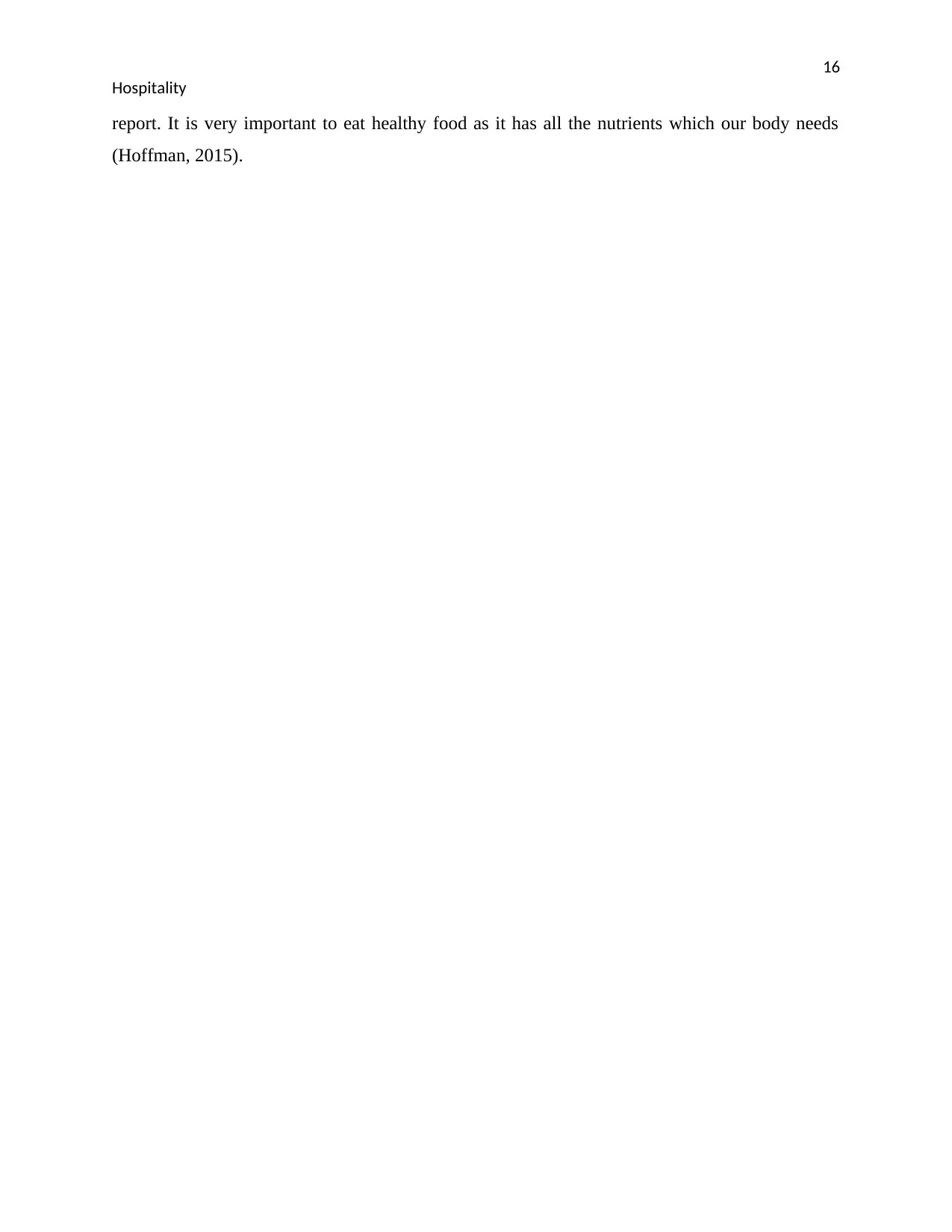
16
Hospitality
report. It is very important to eat healthy food as it has all the nutrients which our body needs
(Hoffman, 2015).
Hospitality
report. It is very important to eat healthy food as it has all the nutrients which our body needs
(Hoffman, 2015).
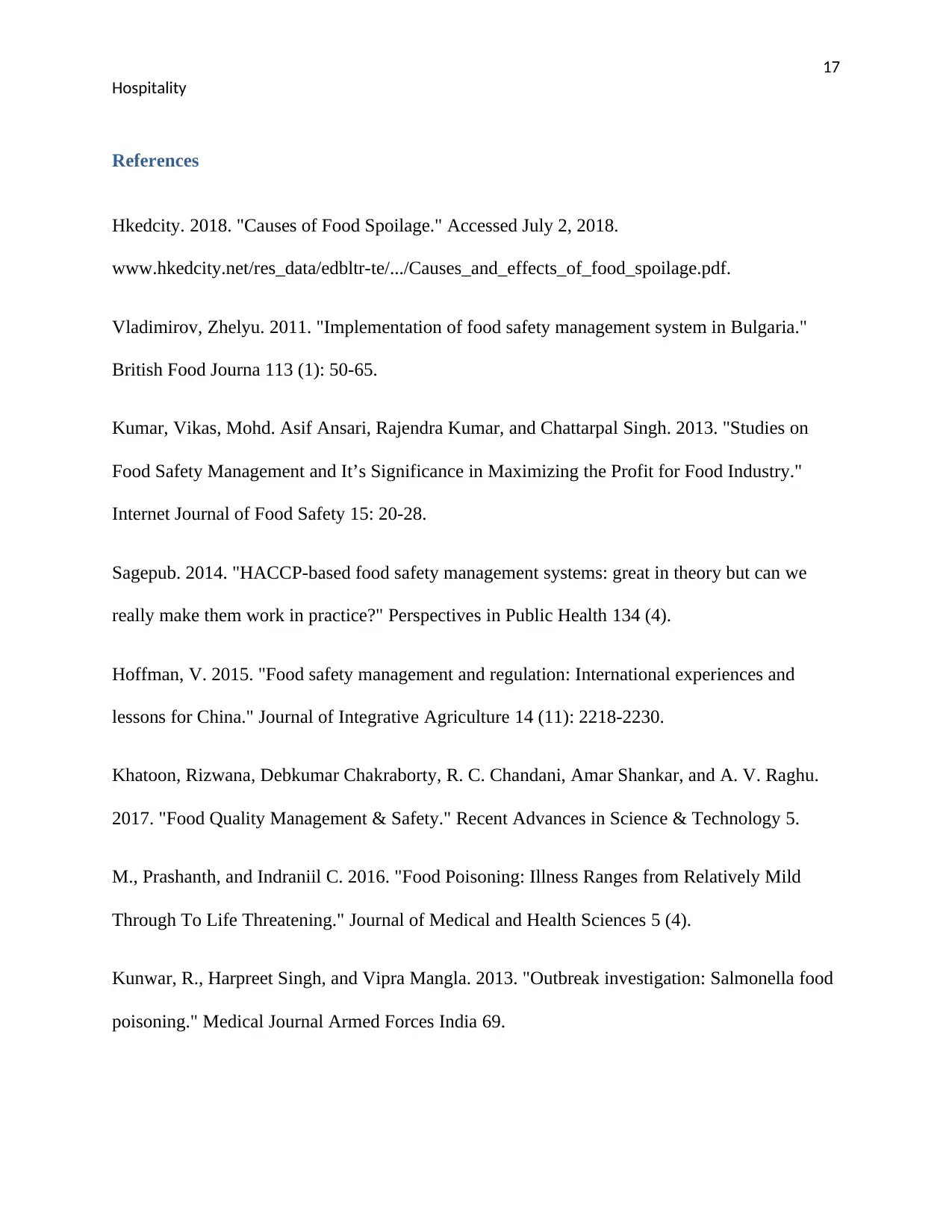
17
Hospitality
References
Hkedcity. 2018. "Causes of Food Spoilage." Accessed July 2, 2018.
www.hkedcity.net/res_data/edbltr-te/.../Causes_and_effects_of_food_spoilage.pdf.
Vladimirov, Zhelyu. 2011. "Implementation of food safety management system in Bulgaria."
British Food Journa 113 (1): 50-65.
Kumar, Vikas, Mohd. Asif Ansari, Rajendra Kumar, and Chattarpal Singh. 2013. "Studies on
Food Safety Management and It’s Significance in Maximizing the Profit for Food Industry."
Internet Journal of Food Safety 15: 20-28.
Sagepub. 2014. "HACCP-based food safety management systems: great in theory but can we
really make them work in practice?" Perspectives in Public Health 134 (4).
Hoffman, V. 2015. "Food safety management and regulation: International experiences and
lessons for China." Journal of Integrative Agriculture 14 (11): 2218-2230.
Khatoon, Rizwana, Debkumar Chakraborty, R. C. Chandani, Amar Shankar, and A. V. Raghu.
2017. "Food Quality Management & Safety." Recent Advances in Science & Technology 5.
M., Prashanth, and Indraniil C. 2016. "Food Poisoning: Illness Ranges from Relatively Mild
Through To Life Threatening." Journal of Medical and Health Sciences 5 (4).
Kunwar, R., Harpreet Singh, and Vipra Mangla. 2013. "Outbreak investigation: Salmonella food
poisoning." Medical Journal Armed Forces India 69.
Hospitality
References
Hkedcity. 2018. "Causes of Food Spoilage." Accessed July 2, 2018.
www.hkedcity.net/res_data/edbltr-te/.../Causes_and_effects_of_food_spoilage.pdf.
Vladimirov, Zhelyu. 2011. "Implementation of food safety management system in Bulgaria."
British Food Journa 113 (1): 50-65.
Kumar, Vikas, Mohd. Asif Ansari, Rajendra Kumar, and Chattarpal Singh. 2013. "Studies on
Food Safety Management and It’s Significance in Maximizing the Profit for Food Industry."
Internet Journal of Food Safety 15: 20-28.
Sagepub. 2014. "HACCP-based food safety management systems: great in theory but can we
really make them work in practice?" Perspectives in Public Health 134 (4).
Hoffman, V. 2015. "Food safety management and regulation: International experiences and
lessons for China." Journal of Integrative Agriculture 14 (11): 2218-2230.
Khatoon, Rizwana, Debkumar Chakraborty, R. C. Chandani, Amar Shankar, and A. V. Raghu.
2017. "Food Quality Management & Safety." Recent Advances in Science & Technology 5.
M., Prashanth, and Indraniil C. 2016. "Food Poisoning: Illness Ranges from Relatively Mild
Through To Life Threatening." Journal of Medical and Health Sciences 5 (4).
Kunwar, R., Harpreet Singh, and Vipra Mangla. 2013. "Outbreak investigation: Salmonella food
poisoning." Medical Journal Armed Forces India 69.
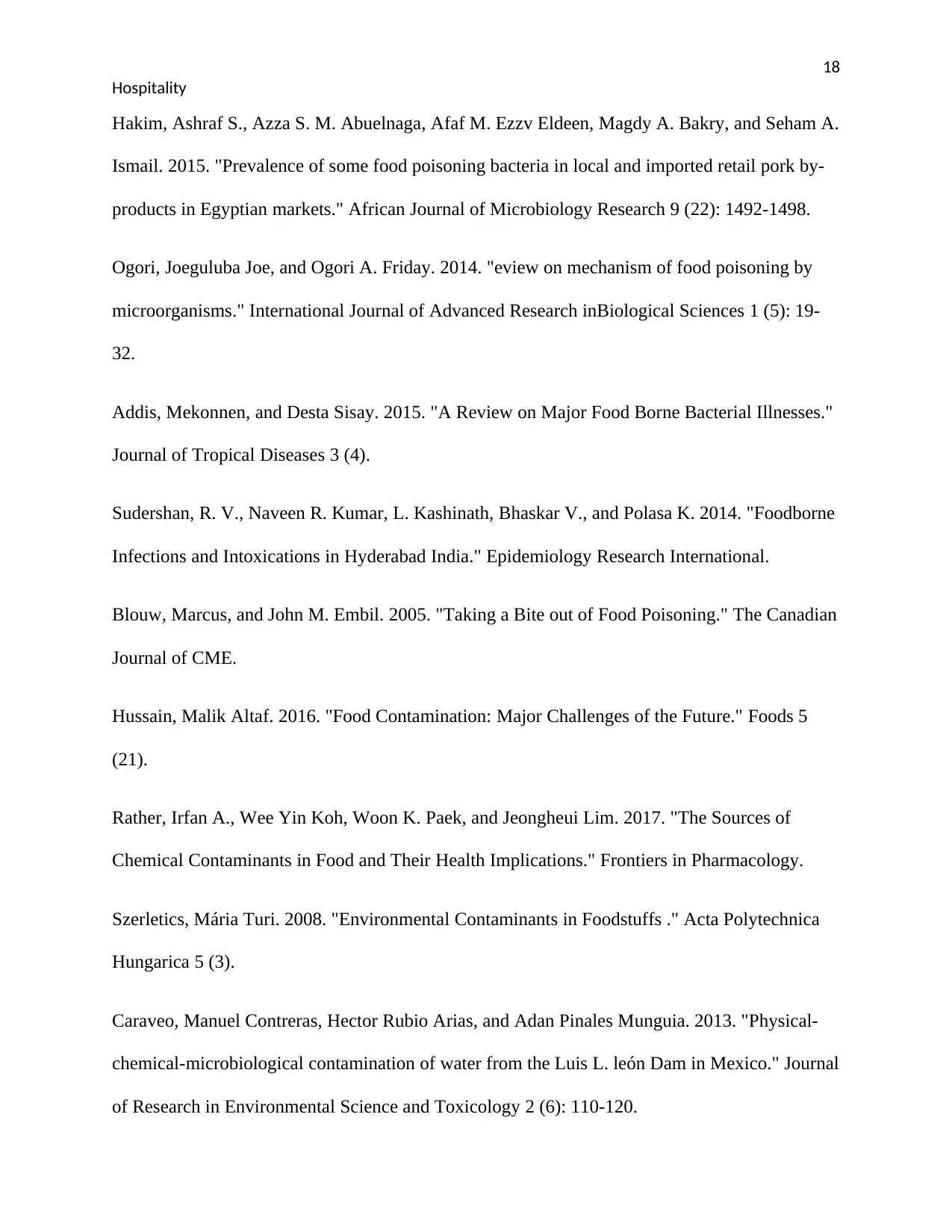
18
Hospitality
Hakim, Ashraf S., Azza S. M. Abuelnaga, Afaf M. Ezzv Eldeen, Magdy A. Bakry, and Seham A.
Ismail. 2015. "Prevalence of some food poisoning bacteria in local and imported retail pork by-
products in Egyptian markets." African Journal of Microbiology Research 9 (22): 1492-1498.
Ogori, Joeguluba Joe, and Ogori A. Friday. 2014. "eview on mechanism of food poisoning by
microorganisms." International Journal of Advanced Research inBiological Sciences 1 (5): 19-
32.
Addis, Mekonnen, and Desta Sisay. 2015. "A Review on Major Food Borne Bacterial Illnesses."
Journal of Tropical Diseases 3 (4).
Sudershan, R. V., Naveen R. Kumar, L. Kashinath, Bhaskar V., and Polasa K. 2014. "Foodborne
Infections and Intoxications in Hyderabad India." Epidemiology Research International.
Blouw, Marcus, and John M. Embil. 2005. "Taking a Bite out of Food Poisoning." The Canadian
Journal of CME.
Hussain, Malik Altaf. 2016. "Food Contamination: Major Challenges of the Future." Foods 5
(21).
Rather, Irfan A., Wee Yin Koh, Woon K. Paek, and Jeongheui Lim. 2017. "The Sources of
Chemical Contaminants in Food and Their Health Implications." Frontiers in Pharmacology.
Szerletics, Mária Turi. 2008. "Environmental Contaminants in Foodstuffs ." Acta Polytechnica
Hungarica 5 (3).
Caraveo, Manuel Contreras, Hector Rubio Arias, and Adan Pinales Munguia. 2013. "Physical-
chemical-microbiological contamination of water from the Luis L. león Dam in Mexico." Journal
of Research in Environmental Science and Toxicology 2 (6): 110-120.
Hospitality
Hakim, Ashraf S., Azza S. M. Abuelnaga, Afaf M. Ezzv Eldeen, Magdy A. Bakry, and Seham A.
Ismail. 2015. "Prevalence of some food poisoning bacteria in local and imported retail pork by-
products in Egyptian markets." African Journal of Microbiology Research 9 (22): 1492-1498.
Ogori, Joeguluba Joe, and Ogori A. Friday. 2014. "eview on mechanism of food poisoning by
microorganisms." International Journal of Advanced Research inBiological Sciences 1 (5): 19-
32.
Addis, Mekonnen, and Desta Sisay. 2015. "A Review on Major Food Borne Bacterial Illnesses."
Journal of Tropical Diseases 3 (4).
Sudershan, R. V., Naveen R. Kumar, L. Kashinath, Bhaskar V., and Polasa K. 2014. "Foodborne
Infections and Intoxications in Hyderabad India." Epidemiology Research International.
Blouw, Marcus, and John M. Embil. 2005. "Taking a Bite out of Food Poisoning." The Canadian
Journal of CME.
Hussain, Malik Altaf. 2016. "Food Contamination: Major Challenges of the Future." Foods 5
(21).
Rather, Irfan A., Wee Yin Koh, Woon K. Paek, and Jeongheui Lim. 2017. "The Sources of
Chemical Contaminants in Food and Their Health Implications." Frontiers in Pharmacology.
Szerletics, Mária Turi. 2008. "Environmental Contaminants in Foodstuffs ." Acta Polytechnica
Hungarica 5 (3).
Caraveo, Manuel Contreras, Hector Rubio Arias, and Adan Pinales Munguia. 2013. "Physical-
chemical-microbiological contamination of water from the Luis L. león Dam in Mexico." Journal
of Research in Environmental Science and Toxicology 2 (6): 110-120.
Paraphrase This Document
Need a fresh take? Get an instant paraphrase of this document with our AI Paraphraser
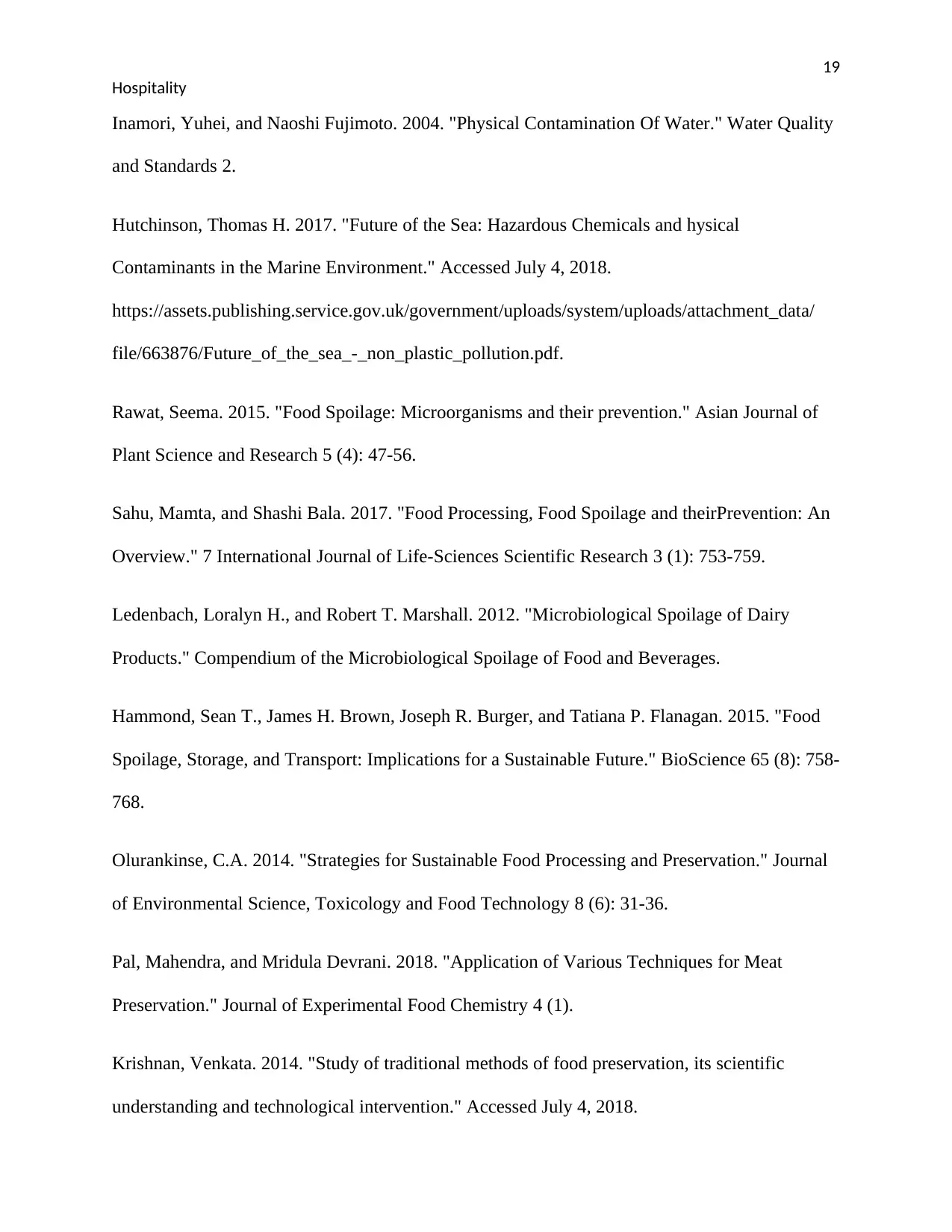
19
Hospitality
Inamori, Yuhei, and Naoshi Fujimoto. 2004. "Physical Contamination Of Water." Water Quality
and Standards 2.
Hutchinson, Thomas H. 2017. "Future of the Sea: Hazardous Chemicals and hysical
Contaminants in the Marine Environment." Accessed July 4, 2018.
https://assets.publishing.service.gov.uk/government/uploads/system/uploads/attachment_data/
file/663876/Future_of_the_sea_-_non_plastic_pollution.pdf.
Rawat, Seema. 2015. "Food Spoilage: Microorganisms and their prevention." Asian Journal of
Plant Science and Research 5 (4): 47-56.
Sahu, Mamta, and Shashi Bala. 2017. "Food Processing, Food Spoilage and theirPrevention: An
Overview." 7 International Journal of Life-Sciences Scientific Research 3 (1): 753-759.
Ledenbach, Loralyn H., and Robert T. Marshall. 2012. "Microbiological Spoilage of Dairy
Products." Compendium of the Microbiological Spoilage of Food and Beverages.
Hammond, Sean T., James H. Brown, Joseph R. Burger, and Tatiana P. Flanagan. 2015. "Food
Spoilage, Storage, and Transport: Implications for a Sustainable Future." BioScience 65 (8): 758-
768.
Olurankinse, C.A. 2014. "Strategies for Sustainable Food Processing and Preservation." Journal
of Environmental Science, Toxicology and Food Technology 8 (6): 31-36.
Pal, Mahendra, and Mridula Devrani. 2018. "Application of Various Techniques for Meat
Preservation." Journal of Experimental Food Chemistry 4 (1).
Krishnan, Venkata. 2014. "Study of traditional methods of food preservation, its scientific
understanding and technological intervention." Accessed July 4, 2018.
Hospitality
Inamori, Yuhei, and Naoshi Fujimoto. 2004. "Physical Contamination Of Water." Water Quality
and Standards 2.
Hutchinson, Thomas H. 2017. "Future of the Sea: Hazardous Chemicals and hysical
Contaminants in the Marine Environment." Accessed July 4, 2018.
https://assets.publishing.service.gov.uk/government/uploads/system/uploads/attachment_data/
file/663876/Future_of_the_sea_-_non_plastic_pollution.pdf.
Rawat, Seema. 2015. "Food Spoilage: Microorganisms and their prevention." Asian Journal of
Plant Science and Research 5 (4): 47-56.
Sahu, Mamta, and Shashi Bala. 2017. "Food Processing, Food Spoilage and theirPrevention: An
Overview." 7 International Journal of Life-Sciences Scientific Research 3 (1): 753-759.
Ledenbach, Loralyn H., and Robert T. Marshall. 2012. "Microbiological Spoilage of Dairy
Products." Compendium of the Microbiological Spoilage of Food and Beverages.
Hammond, Sean T., James H. Brown, Joseph R. Burger, and Tatiana P. Flanagan. 2015. "Food
Spoilage, Storage, and Transport: Implications for a Sustainable Future." BioScience 65 (8): 758-
768.
Olurankinse, C.A. 2014. "Strategies for Sustainable Food Processing and Preservation." Journal
of Environmental Science, Toxicology and Food Technology 8 (6): 31-36.
Pal, Mahendra, and Mridula Devrani. 2018. "Application of Various Techniques for Meat
Preservation." Journal of Experimental Food Chemistry 4 (1).
Krishnan, Venkata. 2014. "Study of traditional methods of food preservation, its scientific
understanding and technological intervention." Accessed July 4, 2018.
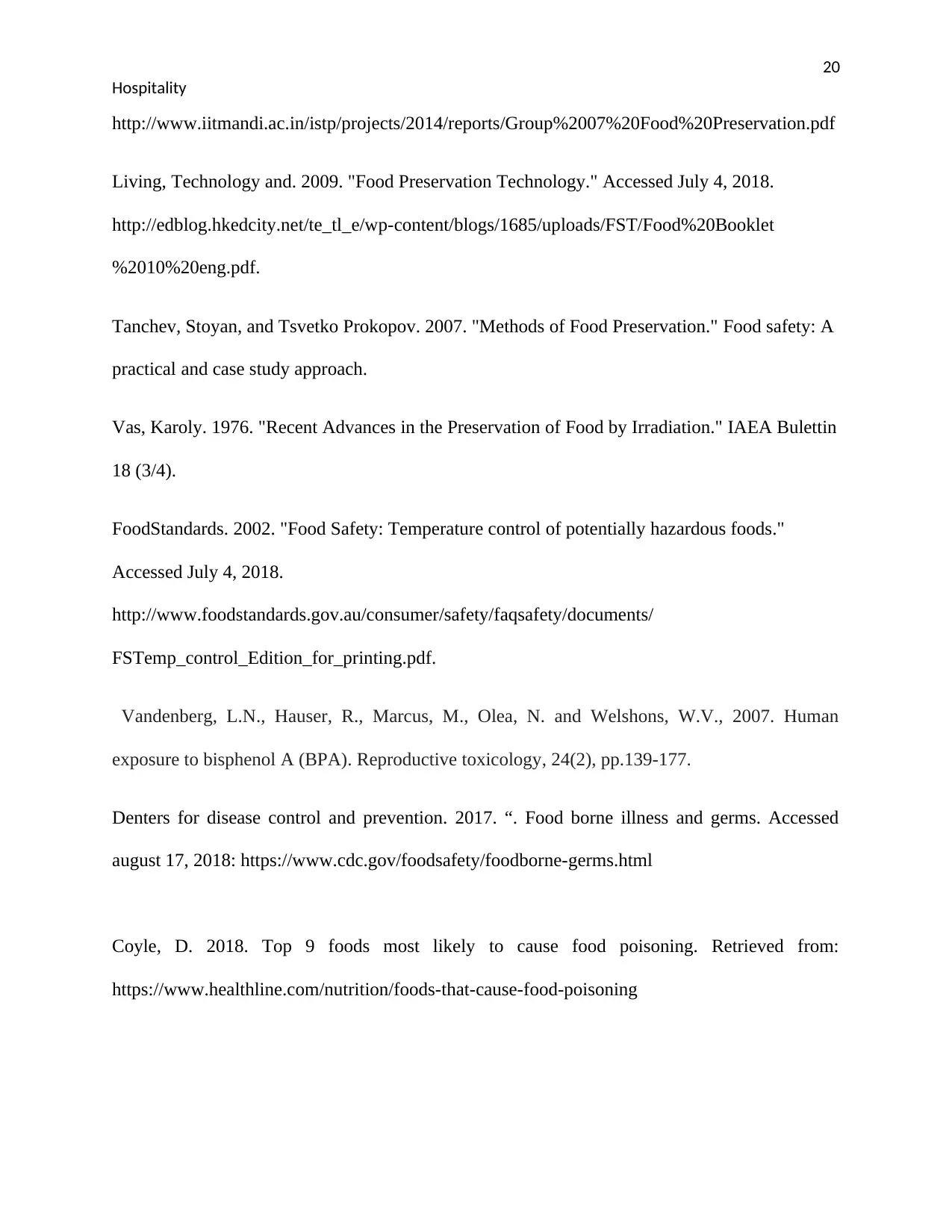
20
Hospitality
http://www.iitmandi.ac.in/istp/projects/2014/reports/Group%2007%20Food%20Preservation.pdf
Living, Technology and. 2009. "Food Preservation Technology." Accessed July 4, 2018.
http://edblog.hkedcity.net/te_tl_e/wp-content/blogs/1685/uploads/FST/Food%20Booklet
%2010%20eng.pdf.
Tanchev, Stoyan, and Tsvetko Prokopov. 2007. "Methods of Food Preservation." Food safety: A
practical and case study approach.
Vas, Karoly. 1976. "Recent Advances in the Preservation of Food by Irradiation." IAEA Bulettin
18 (3/4).
FoodStandards. 2002. "Food Safety: Temperature control of potentially hazardous foods."
Accessed July 4, 2018.
http://www.foodstandards.gov.au/consumer/safety/faqsafety/documents/
FSTemp_control_Edition_for_printing.pdf.
Vandenberg, L.N., Hauser, R., Marcus, M., Olea, N. and Welshons, W.V., 2007. Human
exposure to bisphenol A (BPA). Reproductive toxicology, 24(2), pp.139-177.
Denters for disease control and prevention. 2017. “. Food borne illness and germs. Accessed
august 17, 2018: https://www.cdc.gov/foodsafety/foodborne-germs.html
Coyle, D. 2018. Top 9 foods most likely to cause food poisoning. Retrieved from:
https://www.healthline.com/nutrition/foods-that-cause-food-poisoning
Hospitality
http://www.iitmandi.ac.in/istp/projects/2014/reports/Group%2007%20Food%20Preservation.pdf
Living, Technology and. 2009. "Food Preservation Technology." Accessed July 4, 2018.
http://edblog.hkedcity.net/te_tl_e/wp-content/blogs/1685/uploads/FST/Food%20Booklet
%2010%20eng.pdf.
Tanchev, Stoyan, and Tsvetko Prokopov. 2007. "Methods of Food Preservation." Food safety: A
practical and case study approach.
Vas, Karoly. 1976. "Recent Advances in the Preservation of Food by Irradiation." IAEA Bulettin
18 (3/4).
FoodStandards. 2002. "Food Safety: Temperature control of potentially hazardous foods."
Accessed July 4, 2018.
http://www.foodstandards.gov.au/consumer/safety/faqsafety/documents/
FSTemp_control_Edition_for_printing.pdf.
Vandenberg, L.N., Hauser, R., Marcus, M., Olea, N. and Welshons, W.V., 2007. Human
exposure to bisphenol A (BPA). Reproductive toxicology, 24(2), pp.139-177.
Denters for disease control and prevention. 2017. “. Food borne illness and germs. Accessed
august 17, 2018: https://www.cdc.gov/foodsafety/foodborne-germs.html
Coyle, D. 2018. Top 9 foods most likely to cause food poisoning. Retrieved from:
https://www.healthline.com/nutrition/foods-that-cause-food-poisoning
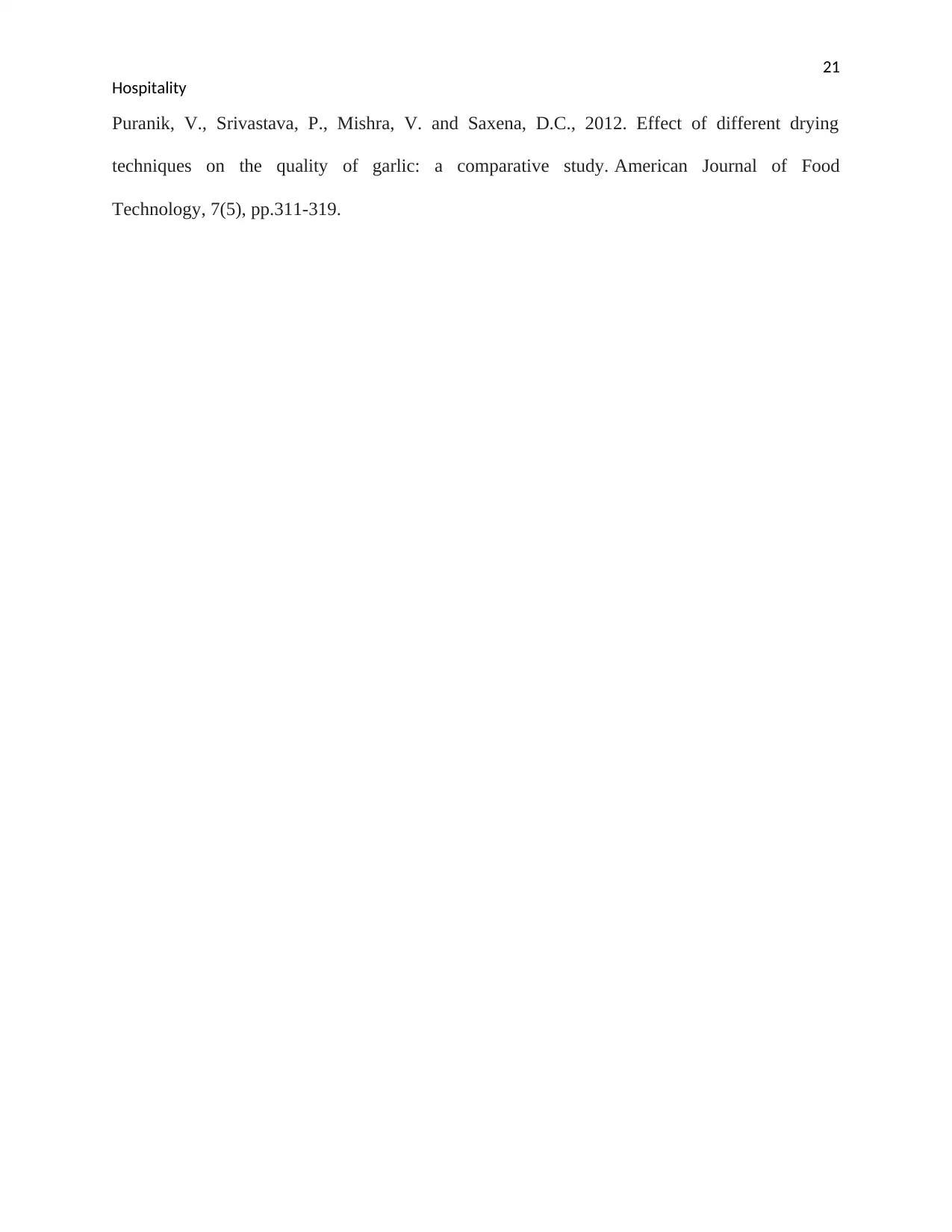
21
Hospitality
Puranik, V., Srivastava, P., Mishra, V. and Saxena, D.C., 2012. Effect of different drying
techniques on the quality of garlic: a comparative study. American Journal of Food
Technology, 7(5), pp.311-319.
Hospitality
Puranik, V., Srivastava, P., Mishra, V. and Saxena, D.C., 2012. Effect of different drying
techniques on the quality of garlic: a comparative study. American Journal of Food
Technology, 7(5), pp.311-319.
1 out of 22
Related Documents
Your All-in-One AI-Powered Toolkit for Academic Success.
+13062052269
info@desklib.com
Available 24*7 on WhatsApp / Email
![[object Object]](/_next/static/media/star-bottom.7253800d.svg)
Unlock your academic potential
© 2024 | Zucol Services PVT LTD | All rights reserved.





